| Home; Aviation; Cameras; Fiction; Health&Safety; Military; MS-Apps; Non-Fiction; Submarine; Technical; Trains; Watches; Transportation |
|---|
1962 Supersonic Aircraft Escape Module
Some information and photographs regarding the B-58 Hustler are courtesy of Wikipedia, the free encyclopedia.
Edited by David Barth 28 February 2012. Images were scanned by David Barth.
These pages are from an uncopyrighted pamphlet written in 1962 during flight tests of the Supersonic B-58 Hustler bomber for which the escape module was designed. Most of the text is transcribed below the picture with the text.
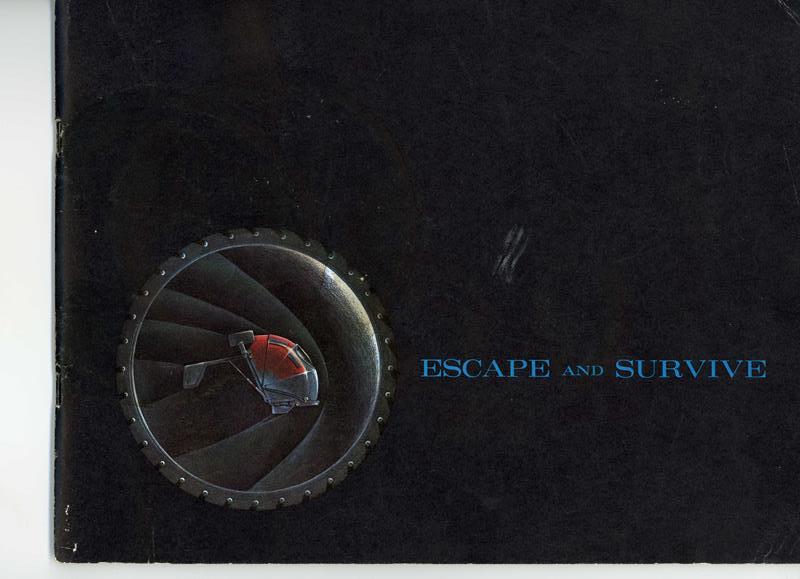 |
| 1962 Supersonic Aircraft Escape Module. |
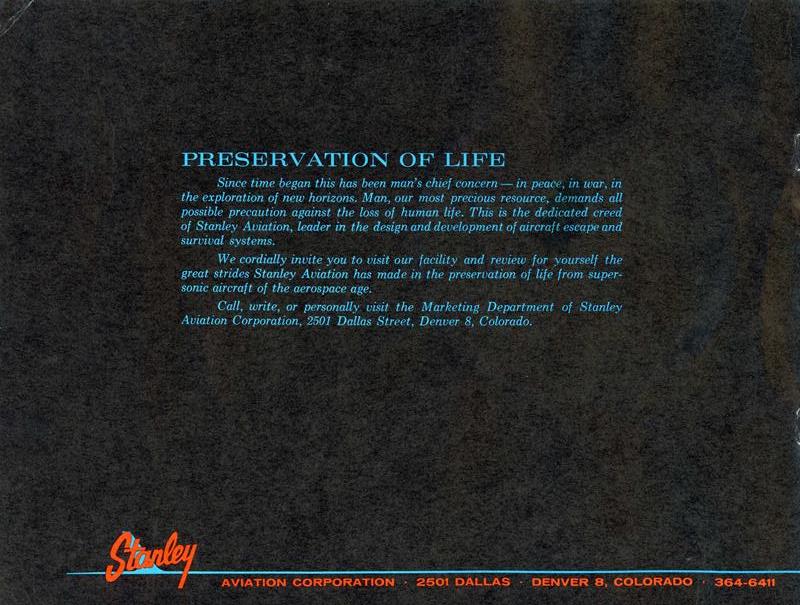 |
| 1962 Supersonic Aircraft Escape Module. |
PRESERVATION OF LIFE
Since time began this has been man's chief concern - in peace, in war, in the exploration of new horizons. Man, our most precious resource, demands all possible precaution against the loss of human life. This is the dedicated creed of Stanley Aviation, leader in the design and development of aircraft escape and survival systems.
We cordially invite you to visit our facility and review for yourself the great strides Stanley Aviation has made in the preservation of life from supersonic aircraft of the aerospace age.
Call, write, or personally visit the Marketing Department of Stanley Aviation Corporation, 2501 Dallas Street, Denver 8, Colorado. [This was written in 1962, before the advent of Zip Codes, and during the development of the North American B58 Hustler Supersonic Bomber.]
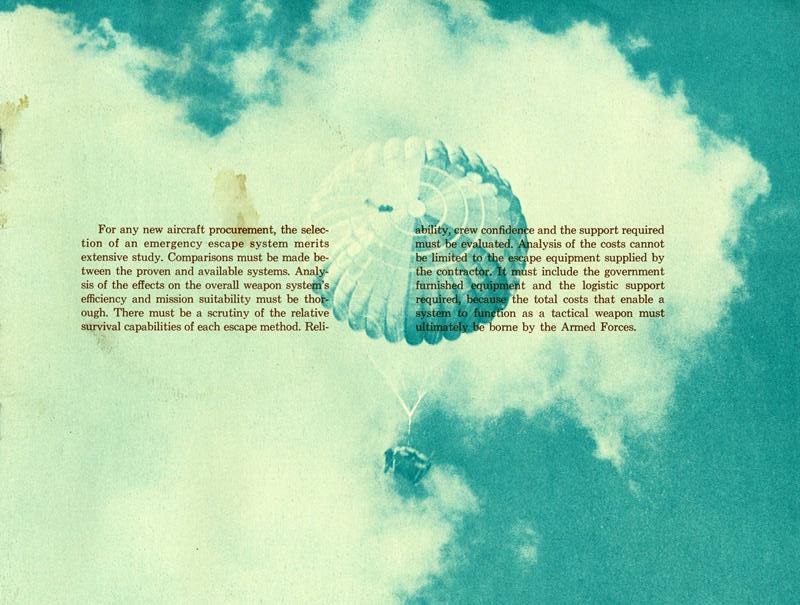 |
| 1962 Supersonic Aircraft Escape Module. |
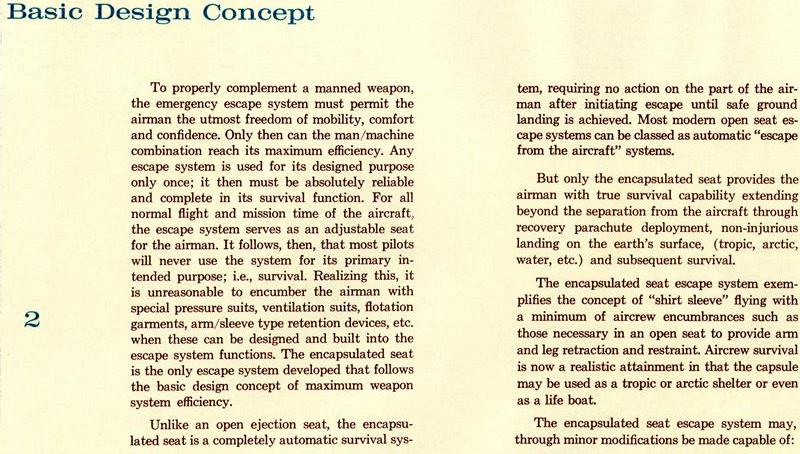 |
| 1962 Supersonic Aircraft Escape Module. |
Basic Design Concept
To properly complement a manned weapon, the emergency escape system must permit the airman the utmost freedom of mobility, comfort and confidence. Only then can the man/machine combination reach its maximum efficiency. Any escape system is used for its designed purpose only once; it then must be absolutely reliable and complete in its survival function. For all normal flight and mission time of the aircraft, the escape system serves as an adjustable seat for the airman. It follows, then, that most pilots will never use the system for its primary intended purpose; i.e., survival. Realizing this, it is unreasonable to encumber the airman with special pressure suits, ventilation suits, flotation garments, arm/sleeve type retention devices, etc. when these can be designed and built into the escape system functions. The encapsulated seat is the only escape system developed that follows the basic design concept of maximum weapon system efficiency.
Unlike an open ejection seat, the encapsulated seat is a completely automatic survival system, requiring no action on the part of the airman after initiating escape until safe ground landing is achieved. Most modern open seat escape systems can be classed as automatic "escape from the aircraft" systems.
But only the encapsulated seat provides the airman with true survival capability extending beyond the separation from the aircraft through recovery parachute deployment, non-injurious landing on the earth's surface, (tropic, arctic, water, etc.) and subsequent survival.
The encapsulated seat escape system exemplifies the concept of "shirt sleeve" flying with a minimum of aircrew encumbrances such as those necessary in an open seat to provide arm and leg retraction and restraint. Aircrew survival is now a realistic attainment in that the capsule may be used as a tropic or arctic shelter or even as a life boat.
The encapsulated seat escape system may, through minor modifications be made capable of:
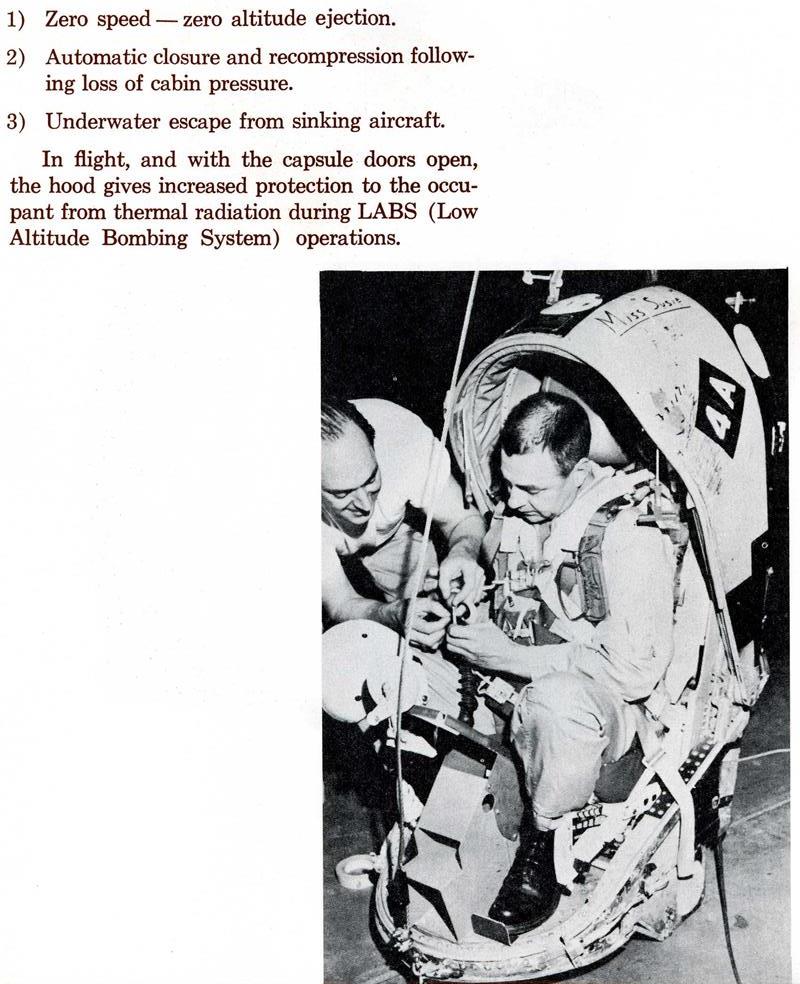 |
| 1962 Supersonic Aircraft Escape Module. |
1) Zero speed - zero altitude ejection.
2) Automatic closure and recompression following loss of cabin pressure.
3) Underwater escape from sinking aircraft.
In flight, and with the capsule doors open, the hood gives increased protection to the occupant from thermal radiation during LABS (Low Altitude Bombing System) operations.
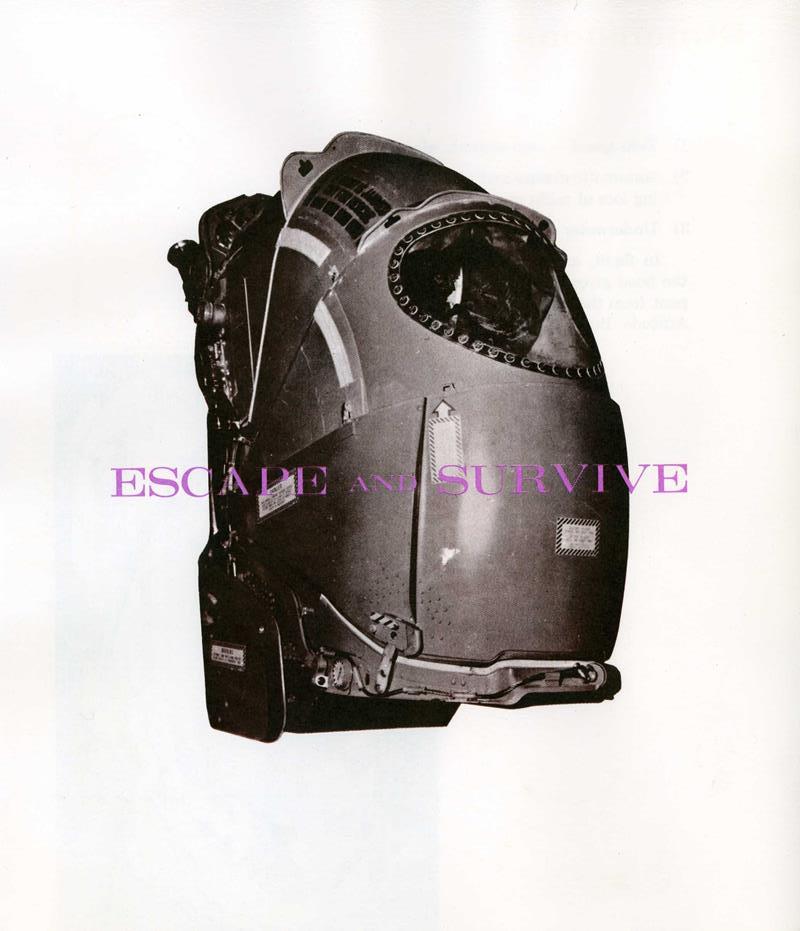 |
| 1962 Supersonic Aircraft Escape Module. |
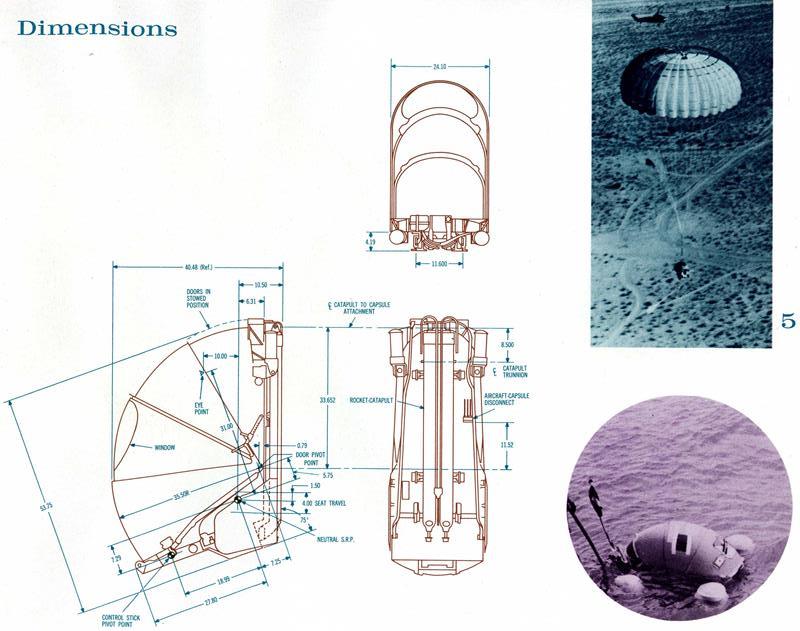 |
| 1962 Supersonic Aircraft Escape Module. |
 |
| 1962 Supersonic Aircraft Escape Module. |
Survival On Land
On land the capsule is a small house. Its rigid metallic walls protect the occupant against all elements and natural enemies. On the desert it is an enclosure against sandstorms, in the north, against blizzards. Arctic clothing makes survival possible at 60 degrees below zero F. In the tropics the capsule gives added security against animals and insects. If there is a waterside landing, a river or a lake crossing is feasible. From the parachute and items in the capsule it is possible to improvise a sail and a paddle.
An elaborate survival kit, packed in plastic containers with maximum economy of space, includes a three-day water and a fourteen-day food supply. Hunting, trapping and fishing gear greatly enhance the occupant's chances for life.
A two-way transistorized radio with an extra, long-life battery, and other signaling devices, permit contact with search parties. Pathfinding-navigational equipment enables the survivor to fix his position and guide rescuers or set a likely return route to safety.
A first aid pack, all-climate survival instructions and versatile tools, place the results of extensive experience and research at the service of the lone crew member in a few small packages.
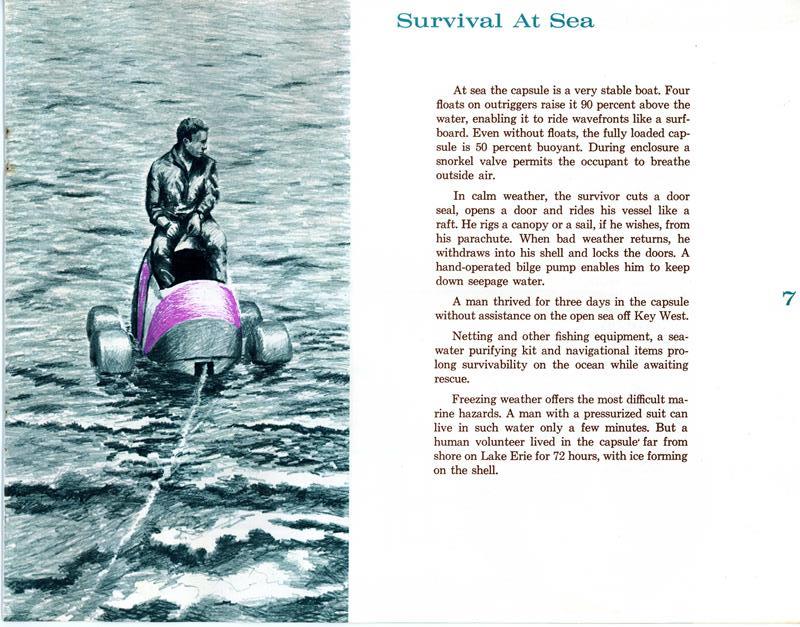 |
| 1962 Supersonic Aircraft Escape Module. |
Survival At Sea
At sea the capsule is a very stable boat. Four floats on outriggers raise it 90 percent above the water, enabling it to ride wavefronts like a surfboard. Even without floats, the fully loaded capsule is 50 percent buoyant. During enclosure a snorkel valve permits the occupant to breathe outside air.
In calm weather, the survivor cuts a door seal, opens a door and rides his vessel like a raft. He rigs a canopy or a sail, if he wishes, from his parachute. When bad weather returns, he withdraws into his shell and locks the doors. A hand-operated bilge pump enables him to keep down seepage water.
A man thrived for three days in the capsule without assistance on the open sea off Key West.
Netting and other fishing equipment, a sea water purifying kit, and navigational items prolong survivability on the ocean while awaiting rescue.
Freezing weather offers the most difficult marine hazards. A man with a pressurized suit can live in such water only a few minutes. But a human volunteer lived in the capsu1e far from shore on Lake Erie for 72 hours, with ice forming on the shell.
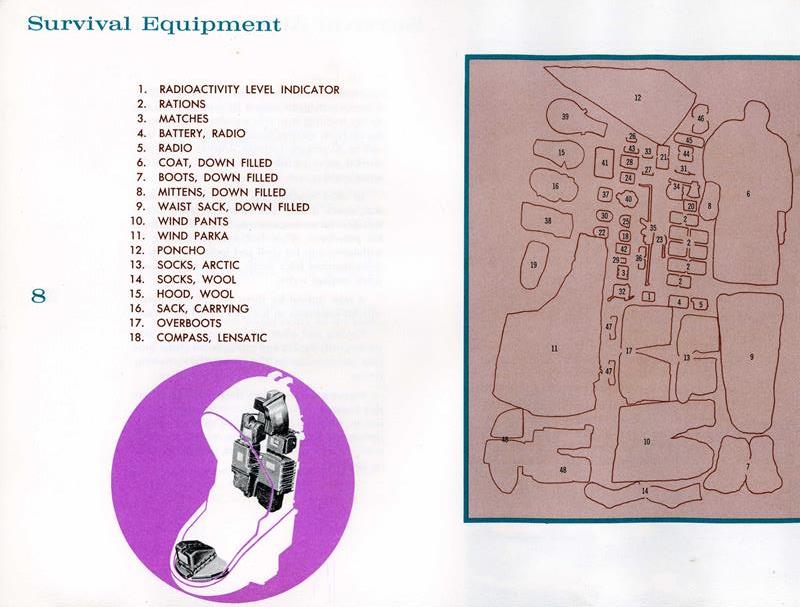 |
| 1962 Supersonic Aircraft Escape Module. |
Survival Equipment
1. RADIOACTIVITY LEVEL INDICATOR
2. RATIONS
3. MATCHES
4. BATTERY, RADIO
5. RADIO
6. COAT, DOWN FILLED
7. BOOTS, DOWN FILLED
8. MITTENS, DOWN FILLED
9. WAIST SACK, DOWN FILLED
10. WIND PANTS
11. WIND PARKA
12. PONCHO
13. SOCKS, ARCTIC
14. SOCKS, WOOL
15. HOOD, WOOL
16. SACK, CARRYING
17. OVERBOOTS
18. COMPASS, LENSATIC
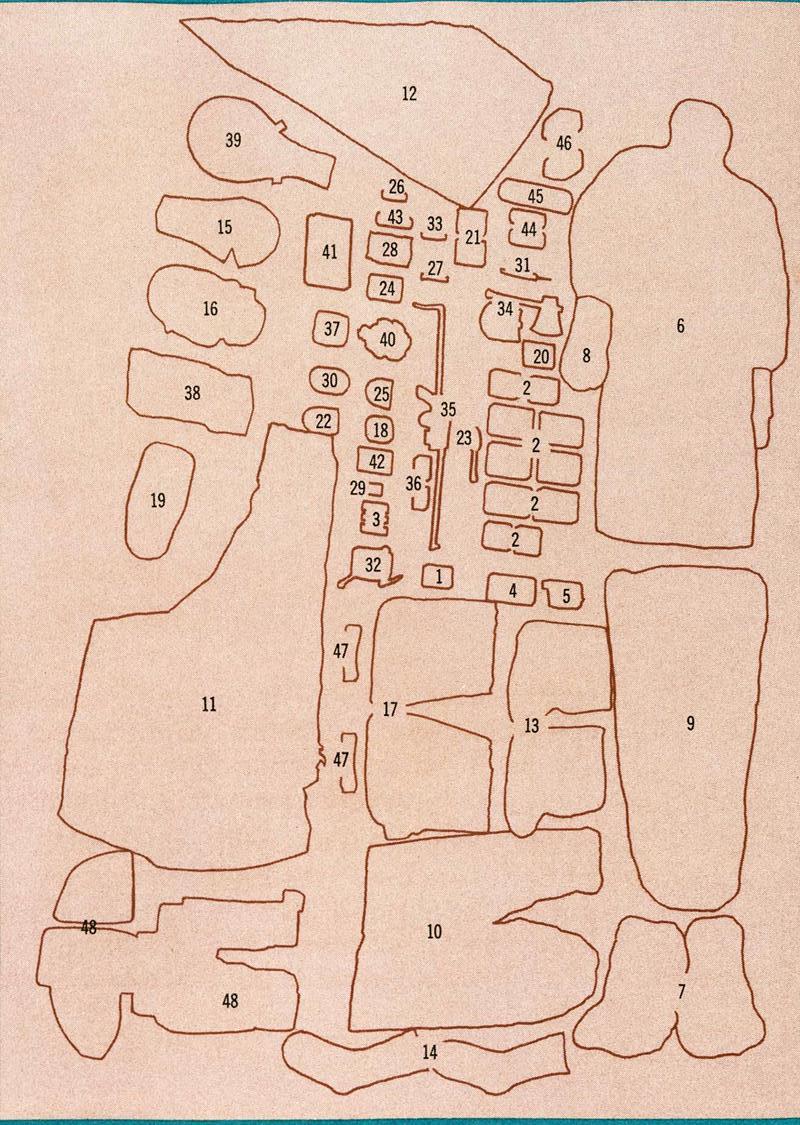 |
| 1962 Supersonic Aircraft Escape Module. |
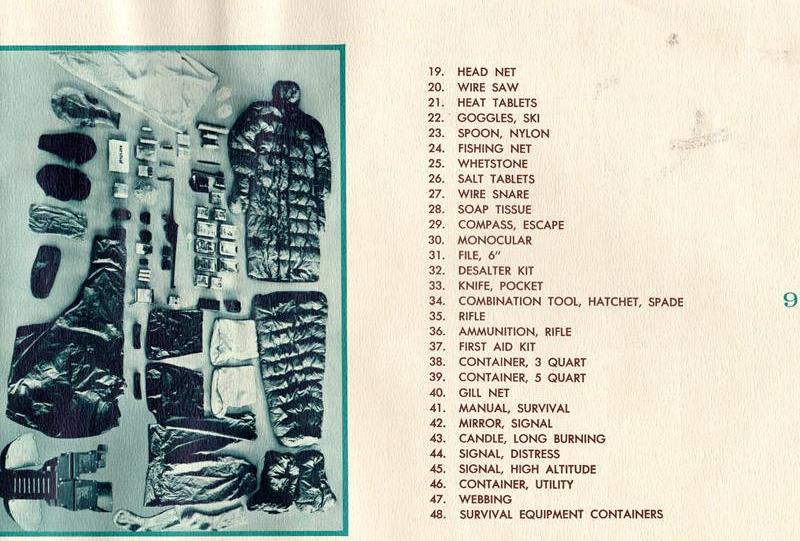 |
| 1962 Supersonic Aircraft Escape Module. |
19. HEAD NET
20. WIRE SAW
21. HEAT TABLETS
22. GOGGLES, SKI
23. SPOON, NYLON
24. FISHING NET
25. WHETSTONE
26. SALT TABLETS
27. WIRE SNARE
28. SOAP TISSUE
29. COMPASS, ESCAPE
30. MONOCULAR
31. FILE, 6 inch
32. DESALTER KIT
33. KNIFE, POCKET
34. COMBINATION TOOL, HATCHET, SPADE
35. RIFLE
36. AMMUNITION, RIFLE
37. FIRST AID KIT
38. CONTAINER, 3 QUART
39. CONTAINER, 5 QUART
40. GILL NET
41. MANUAL, SURVIVAL
42. MIRROR, SIGNAL
43. CANDLE, LONG BURNING
44. SIGNAL, DISTRESS
45. SIGNAL, HIGH ALTITUDE
46. CONTAINER, UTILITY
47. WEBBING
48. SURVIVAL EQUIPMENT CONTAINERS
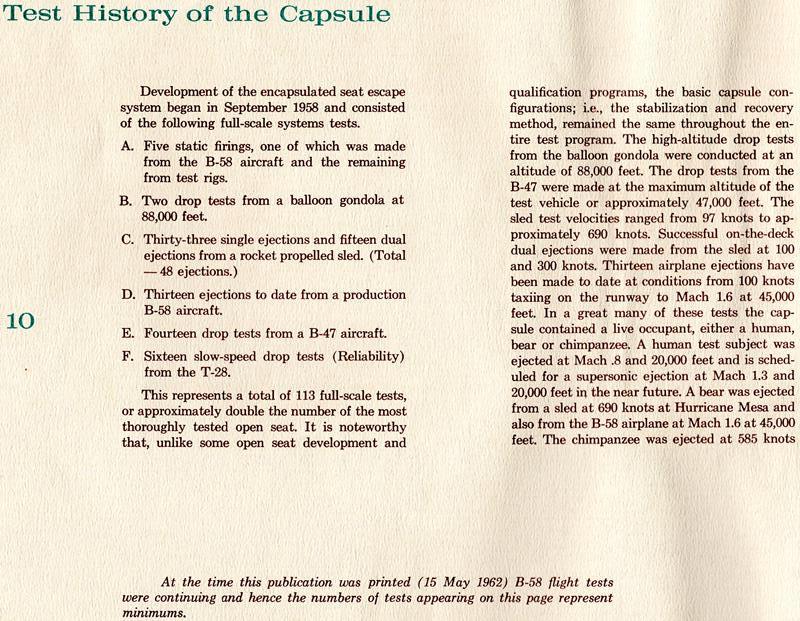 |
| 1962 Supersonic Aircraft Escape Module. |
Test History of the Capsule
Development of the encapsulated seat escape system began in September 1958 and consisted of the following full-scale systems tests.
A. Five static firings, one of which was made from the B-58 aircraft and the remaining from test rigs.
B. Two drop tests from a balloon gondola at 88,000 feet.
C. Thirty-three single ejections and fifteen dual ejections from a rocket propelled sled. (Total - 48 ejections.)
D. Thirteen ejections to date [1962] from a production B-58 aircraft.
E. Fourteen drop tests from a B-47 aircraft.
F. Sixteen slow-speed drop tests (Reliability) from the T-28.
This represents a total of 113 full-scale tests, or approximately double the number of the most thoroughly tested open seat. It is noteworthy that, unlike some open seat development and qualification programs, the basic capsule configurations; i.e., the stabilization and recovery method, remained the same throughout the entire test program. The high-altitude drop tests from the balloon gondola were conducted at an altitude of 88,000 feet. The drop tests from the B-47 were made at the maximum altitude of the test vehicle or approximately 47,000 feet. The sled test velocities ranged from 97 knots to approximately 690 knots. Successful on-the-deck dual ejections were made from the sled at 100 and 300 knots. Thirteen airplane ejections have been made to date at conditions from 100 knots taxiing on the runway to Mach 1.6 at 45,000 feet. In a great many of these tests the capsule contained a live occupant, either a human, bear or chimpanzee. A human test subject was ejected at Mach .8 and 20,000 feet and is scheduled for a supersonic ejection at Mach 1.3 and 20,000 feet in the near future. A bear was ejected from a sled at 690 knots at Hurricane Mesa and also from the B-58 airplane at Mach 1.6 at 45,000 feet. The chimpanzee was ejected at 585 knots [continued on next page]
[NOTE] At the time this publication was printed (15 May 1962) B-58 flight tests were continuing and hence the numbers of tests appearing on this page represent minimums.
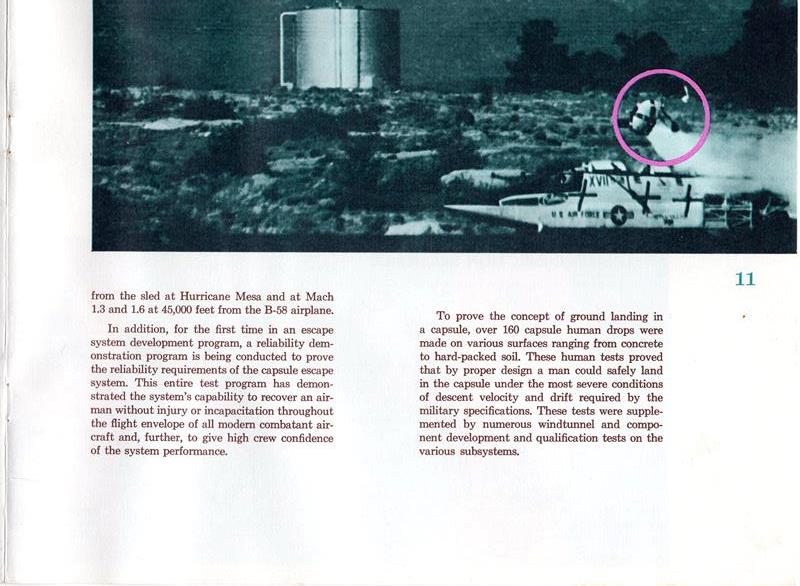 |
| 1962 Supersonic Aircraft Escape Module. |
[continued from previous page]
from the sled at Hurricane Mesa and at Mach 1.3 and 1.6 at 45,000 feet from the B-58 airplane.
In addition, for the first time in an escape system development program, a reliability demonstration program is being conducted to prove the reliability requirements of the capsule escape system. This entire test program has demonstrated the system's capability to recover an airman without injury or incapacitation throughout the flight envelope of all modern combatant aircraft and, further, to give high crew confidence of the system performance.
To prove the concept of ground landing in a capsule, over 160 capsule human drops were made on various surfaces ranging from concrete to bard-packed soil. These human tests proved that by proper design a man could safely land in the capsule under the most severe conditions of descent velocity and drift required by the military specifications. These tests were supplemented by numerous windtunnel and component development and qualification tests on the various subsystems.
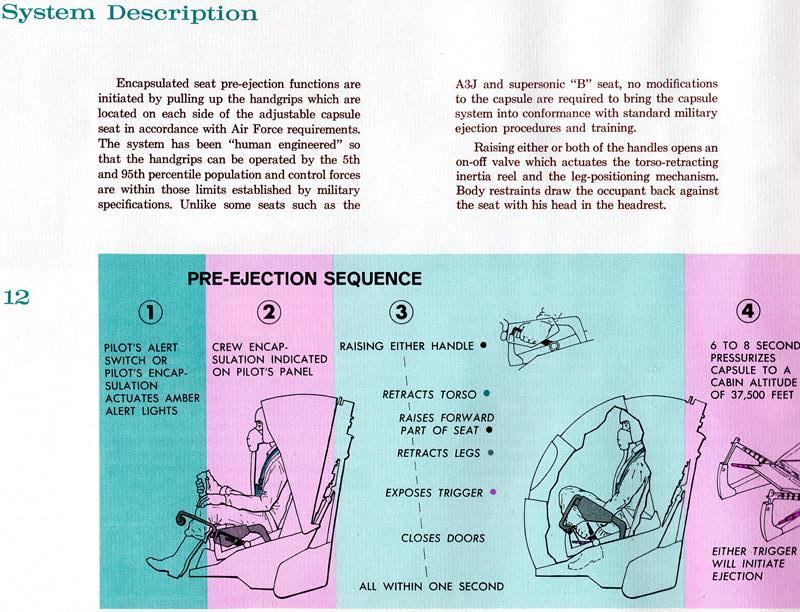 |
| 1962 Supersonic Aircraft Escape Module. |
Encapsulated seat pre-ejection functions are initiated by pulling up the handgrips which are located on each side of the adjustable capsule seat in accordance with Air Force requirements. The system has been "human engineered" so that the handgrips can be operated by the 5th and 95th percentile population and control forces are within those limits established by military specifications. Unlike some seats such as the A3J and supersonic "B" seat, no modifications to the capsule are required to bring the capsule system into conformance with standard military ejection procedures and training.
Raising either or both of the handles opens an on-off valve which actuates the torso-retracting inertia reel and the leg-positioning mechanism. Body restraints draw the occupant back against the seat with his head in the headrest.
PRE-EJECTION SEQUENCE
1. PILOT'S ALERT SWITCH OR PILOT'S ENCAPSULATION ACTIUATES AMBER ALERT LIGHTS
2. CREW ENCAPSULATION INDICATED ON PILOT'S PANEL
3. RAISING EITHER HANDLE
RETRACTS TORSO
RAISES FORWARD PART OF SEAT
RETRACTS LEGS
EXPOSES TRIGGER
CLOSES DOORS ALL WITHIN ONE SECOND
4. 6 TO 8 SECONDS, PRESSURIZES CAPSULE TO A CABIN ALTITUDE OF 37,500 FEET
EITHER TRIGGER WILL INITIATE EJECTION
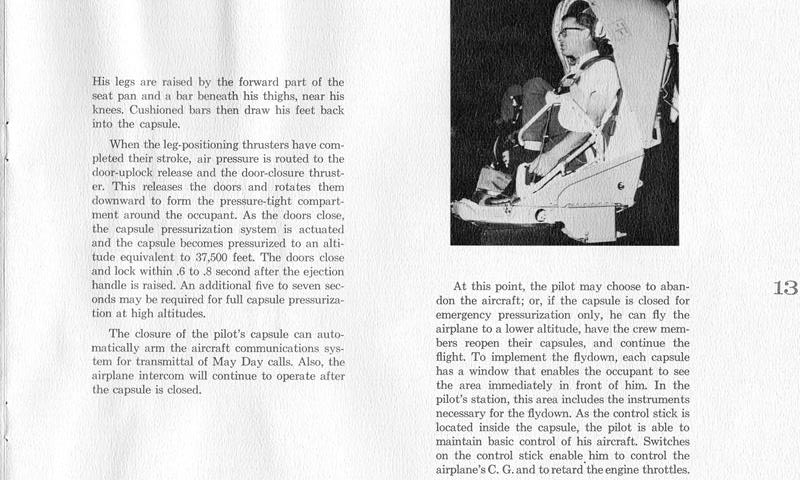 |
| 1962 Supersonic Aircraft Escape Module. |
His legs are raised by the forward part of the seat pan and a bar beneath his thighs, near his knees. Cushioned bars then draw his feet back into the capsule.
When the leg-positioning thrusters have completed their stroke, air pressure is routed to the door-uplock release and the door-closure thruster. This releases the doors and rotates them downward to form the pressure-tight compartment around the occupant. As the doors close, the capsule pressurization system is actuated and the capsule becomes pressurized to an altitude equivalent to 37,500 feet. The doors close and lock within .6 to .8 second after the ejection handle is raised. An additional five to seven seconds may be required for full capsule pressurization at high altitudes.
The closure of the pilot's capsule can automatically arm the aircraft communications system for transmittal of May Day calls. Also, the airplane intercom will continue to operate after the capsule is closed.
At this point, the pilot may choose to abandon the aircraft; or, if the capsule is closed for emergency pressurization only, he can fly the airplane to a lower altitude, have the crew members reopen their capsules, and continue the flight. To implement the flydown, each capsule has a window that enables the occupant to see the area immediately in front of him. In the Pilot's station, this area includes the instruments necessary for the flydown. As the control stick is located inside the capsule, the pilot is able to maintain basic control of his aircraft. Switches on the control stick enable him to control the airplane's C. G. and to retard the engine throttles.
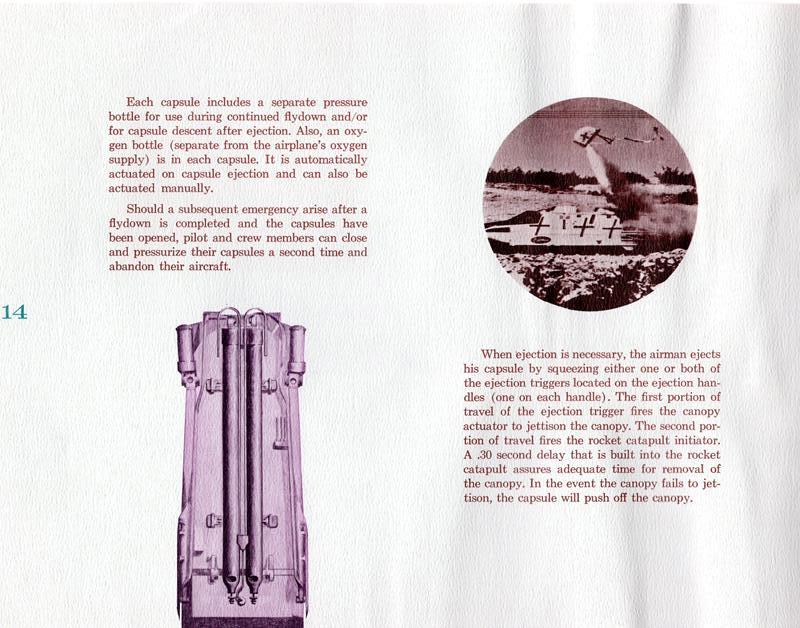 |
| 1962 Supersonic Aircraft Escape Module. |
Each capsule includes a separate pressure bottle for use during continued flydown and/or for capsule descent after ejection. Also, an oxygen bottle (separate from the airplane's oxygen supply) is in each capsule. It is automatically actuated on capsule ejection and can also be actuated manually.
Should a subsequent emergency arise after a flydown is completed and the capsules have been opened, pilot and crew members can close and pressurize their capsules a second time and abandon their aircraft.
When ejection is necessary, the airman ejects his capsule by squeezing either one or both of the ejection triggers located on the ejection handles (one on each handle). The first portion of travel of the ejection trigger fires the canopy actuator to jettison the canopy. The second portion of travel fires the rocket catapult initiator.
A .30 second delay that is built into the rocket catapult assures adequate time for removal of the canopy. In the event the canopy fails to jettison, the capsule will push off the canopy.
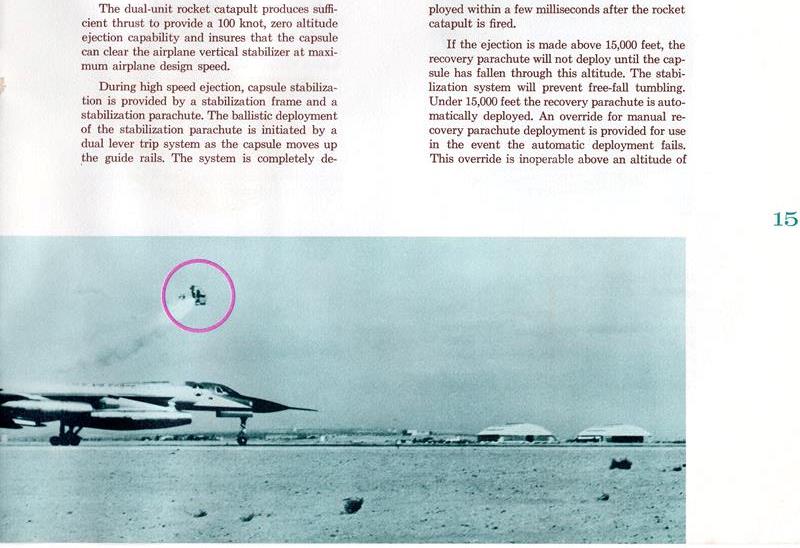 |
| 1962 Supersonic Aircraft Escape Module. |
The dual-unit rocket catapult produces sufficient thrust to provide a 100 knot, zero altitude ejection capability and insures that the capsule can clear the airplane vertical stabilizer at maximum airplane design speed.
During high speed ejection, capsule stabilization is provided by a stabilization frame and a stabilization parachute. The ballistic deployment of the stabilization parachute is initiated by a dual lever trip system as the capsule moves up the guide rails. The system is completely deployed within a few milliseconds after the rocket catapult is fired.
If the ejection is made above 15,000 feet, the recovery parachute will not deploy until the capsule has fallen through this altitude. The stabilization system will prevent free-fall tumbling.
Under 15,000 feet the recovery parachute is automatically deployed. An override for manual recovery parachute deployment is provided for use in the event the automatic deployment fails.
This override is inoperable above an altitude of [continued on next page]
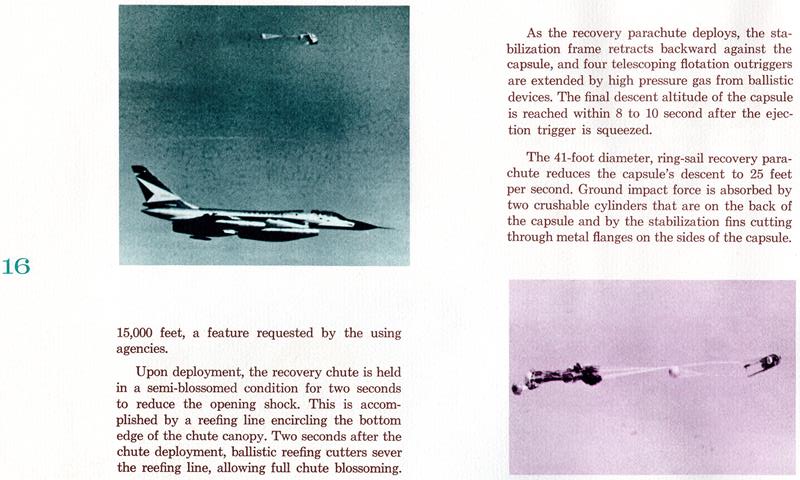 |
| 1962 Supersonic Aircraft Escape Module. |
15,000 feet, a feature requested by the using agencies.
Upon deployment, the recovery chute is held in a semi-blossomed condition for two seconds to reduce the opening shock. This is accomplished by a reefing line encircling the bottom edge of the chute canopy. Two seconds after the chute deployment, ballistic reefing cutters sever the reefing line, allowing full chute blossoming.
As the recovery parachute deploys, the stabilization frame retracts backward against the capsule, and four telescoping flotation outriggers are extended by high pressure gas from ballistic devices. The final descent altitude of the capsule is reached within 8 to 10 seconds after the ejection trigger is squeezed.
The 41-foot diameter, ring-sail recovery parachute reduces the capsule's descent to 25 feet per second. Ground impact force is absorbed by two crushable cylinders that are on the back of the capsule and by the stabilization fins cutting through metal flanges on the sides of the capsule.
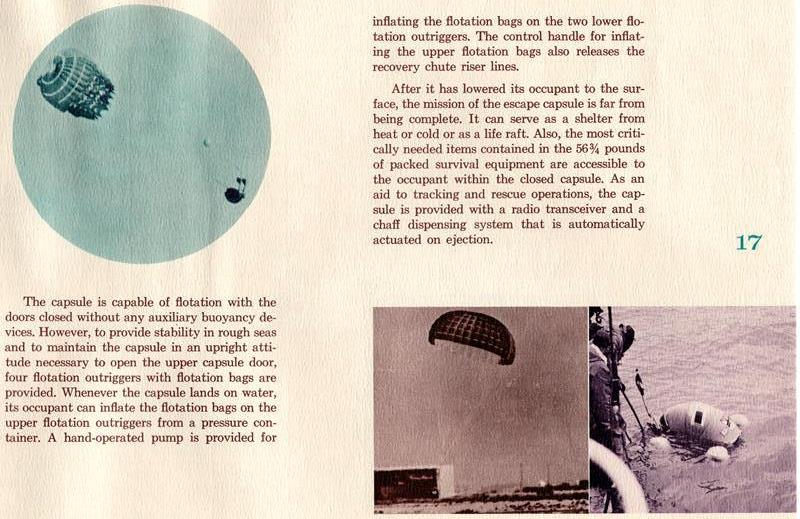 |
| 1962 Supersonic Aircraft Escape Module. |
The capsule is capable of flotation with the doors closed without any auxiliary buoyancy devices. However, to provide stability in rough seas and to maintain the capsule in an upright attitude necessary to open the upper capsule door, four flotation outriggers with flotation bags are provided. Whenever the capsule lands on water, its occupant can inflate the flotation bags on the upper flotation outriggers from a pressure container. A hand-operated pump is provided for inflating the flotation bags on the two lower flotation outriggers. The control handle for inflating the upper flotation bags also releases the recovery chute riser lines.
After it has lowered its occupant to the surface, the mission of the escape capsule is far from being complete. It can serve as a shelter from heat or cold or as a life raft. Also, the most critically needed items contained in the 56/4 pounds of packed survival equipment are accessible to the occupant within the closed capsule. As an aid to tracking and rescue operations, the capsule is provided with a radio transceiver and a chaff dispensing system that is automatically actuated on ejection.
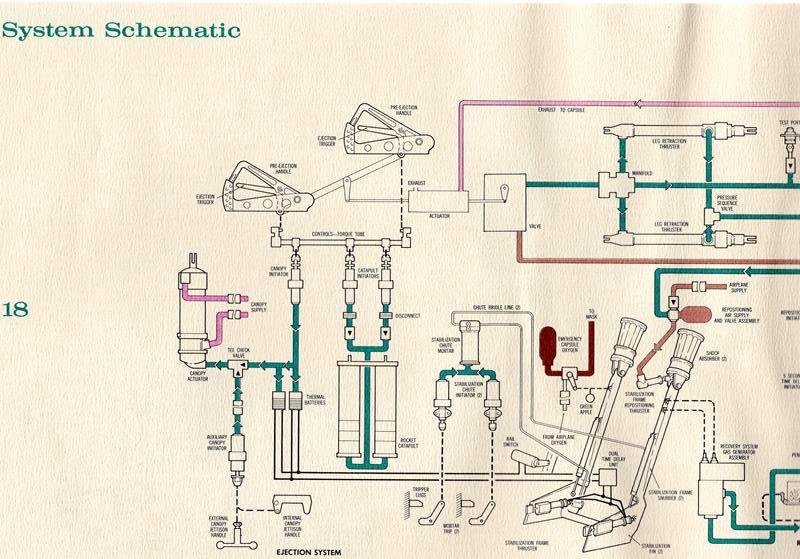 |
| 1962 Supersonic Aircraft Escape Module. |
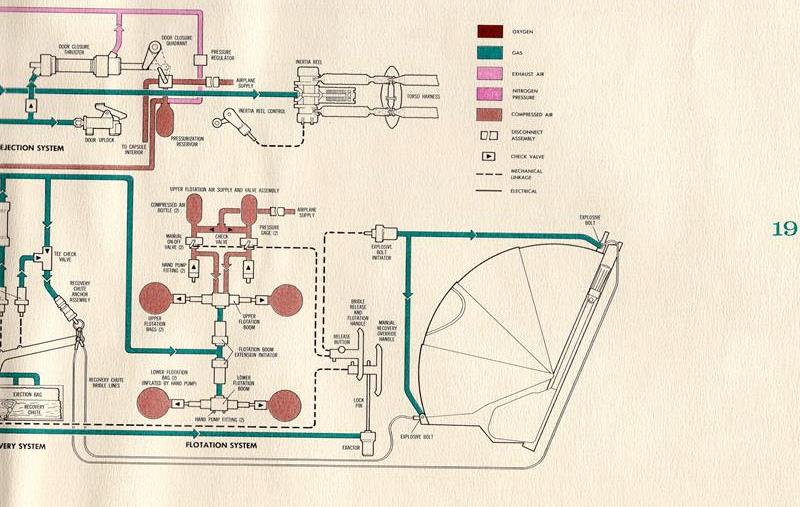 |
| 1962 Supersonic Aircraft Escape Module. |
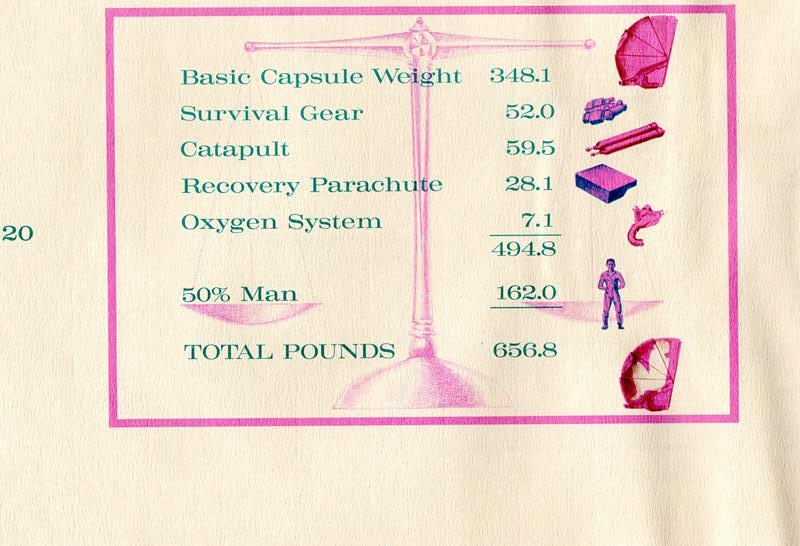 |
| 1962 Supersonic Aircraft Escape Module. |
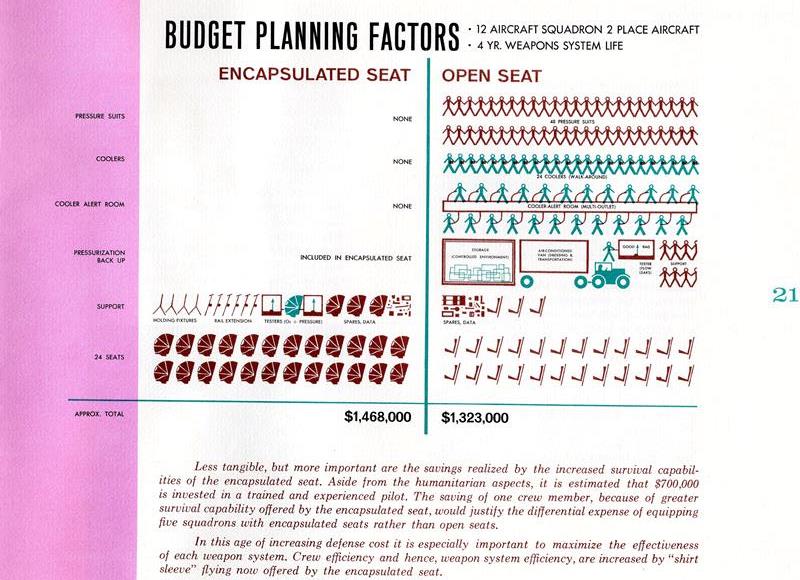 |
| 1962 Supersonic Aircraft Escape Module. |
BUDGET PLANNING FACTORS
12 AIRCRAFT SQUADRONS OF 2-PLACE AIRCRAFT
4 YR. WEAPONS SYSTEM LIFE
Less tangible, but more important are the savings realized by the increased survival capabilities of the encapsulated seat. Aside from the humanitarian aspects, it is estimated that $700,000 is invested in a trained and experienced pilot. The saving of one crew member, because of greater survival capability offered by the encapsulated seat, would justify the differential expense of equipping five squadrons with encapsulated seats rather than open seats.
In this age of increasing defense cost it is especially important to maximize the effectiveness of each weapon system. Crew efficiency and hence, weapon system efficiency, are increased by "shirt sleeve" flying now offered by the encapsulated seat.
COST OF OPEN EJECTION SEAT $1,323,000
COST OF ENCAPSULATED EJECTION SEAT $1,468,000
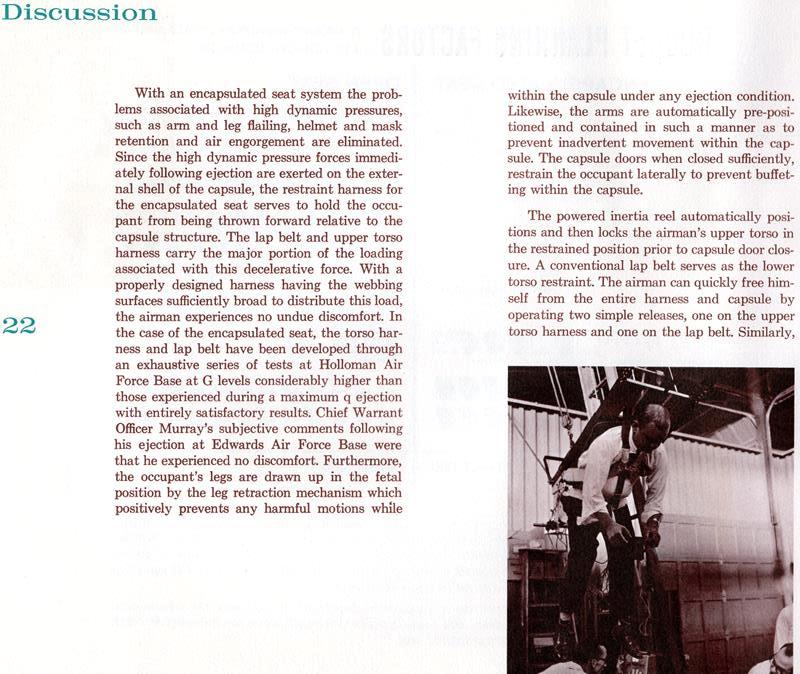 |
| 1962 Supersonic Aircraft Escape Module. |
Discussion
With an encapsulated seat system the problems associated with high dynamic pressures, such as arm and leg flailing, helmet and mask retention and air engorgement are eliminated. Since the high dynamic pressure forces immediately following ejection are exerted on the external shell of the capsule, the restraint harness for the encapsulated seat serves to hold the occupant from being thrown forward relative to the capsule structure. The lap belt and upper torso harness carry the major portion of the loading associated with this decelerative force. With a properly designed harness having the webbing surfaces sufficiently broad to distribute this load, the airman experiences no undue discomfort. In the case of the encapsulated seat, the torso harness and lap belt have been developed through an exhaustive series of tests at Holloman Air Force Base at G levels considerably higher than those experienced during a maximum q ejection with entirely satisfactory results. Chief Warrant Officer Murray's subjective comments following his ejection at Edwards Air Force Base were that he experienced no discomfort. Furthermore, the occupant's legs are drawn up in the fetal position by the leg retraction mechanism which positively prevents any harmful motions while within the capsule under any ejection condition. Likewise, the arms are automatically pre-positioned and contained in such a manner as to prevent inadvertent movement within the capsule. The capsule doors when closed sufficiently, restrain the occupant laterally to prevent buffeting within the capsule.
The powered inertia reel automatically positions and then locks the airman's upper torso in the restrained position prior to capsule door closure. A conventional lap belt serves as the lower torso restraint. The airman can quickly free himself from the entire harness and capsule by operating two simple releases, one on the upper torso harness and one on the lap belt. Similarly, [continued on next page]
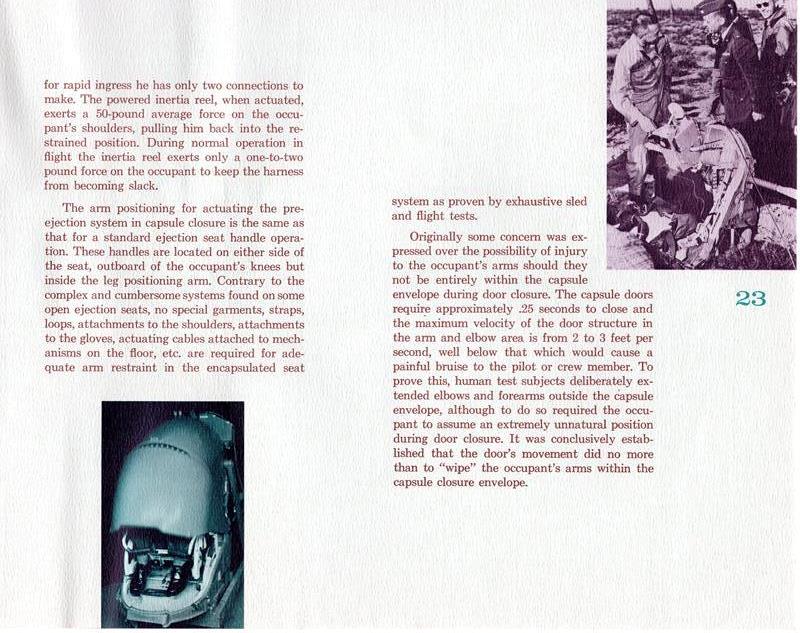 |
| 1962 Supersonic Aircraft Escape Module. |
for rapid ingress he has only two connections to make. The powered inertia reel, when actuated, exerts a 50-pound average force on the occupant's shoulders, pulling him back into the restrained position. During normal operation in flight the inertia reel exerts only a one-to-two pound force on the occupant to keep the harness from becoming slack.
The arm positioning for actuating the pre-ejection system in capsule closure is the same as that for a standard ejection seat handle operation. These handles are located on either side of the seat, outboard of the occupant's knees but inside the leg positioning arm. Contrary to the complex and cumbersome systems found on some open ejection seats, no special garments, straps, loops, attachments to the shoulders, attachments to the gloves, actuating cables attached to mechanisms on the floor, etc. are required for adequate arm restraint in the encapsulated seat system as proven by exhaustive sled and flight tests.
Originally some concern was expressed over the possibility of injury to the occupant's arms should they not be entirely within the capsule envelope during door closure. The capsule doors require approximately .25 seconds to close and the maximum velocity of the door structure in the arm and elbow area is from 2 to 3 feet per second, well below that which would cause a painful bruise to the pilot or crew member. To prove this, human test subjects deliberately extended elbows and forearms outside the capsule envelope, although to do so required the occupant to assume an extremely unnatural position during door closure. It was conclusively established that the door's movement did no more than to "wipe" the occupant's arms within the capsule closure envelope.
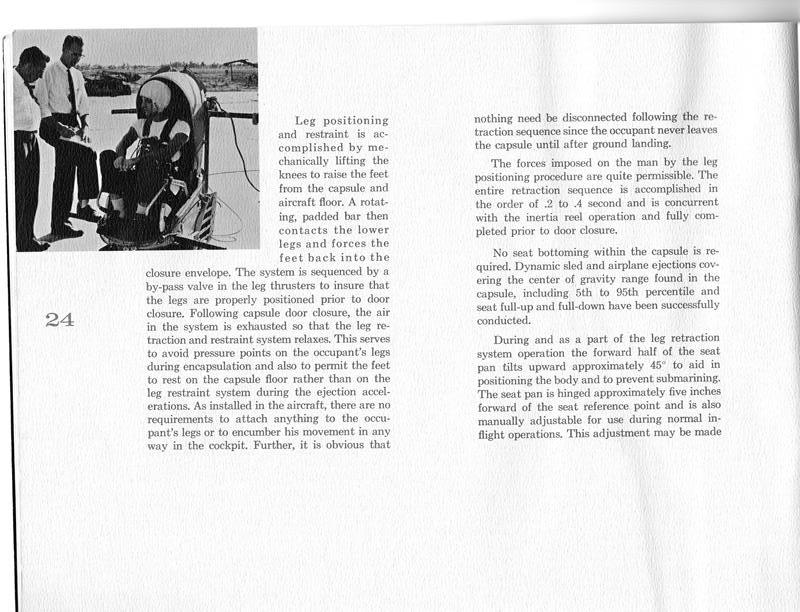 |
| 1962 Supersonic Aircraft Escape Module. |
Leg positioning and restraint is accomplished by mechanically lifting the knees to raise the feet from the capsule and aircraft floor. A rotating, padded bar then contacts the lower legs and forces the feet back into the closure envelope. The system is sequenced by a by-pass valve in the leg thrusters to insure that the legs are properly positioned prior to door closure. Following capsule door closure, the air in the system is exhausted so that the leg retraction and restraint system relaxes. This serves to avoid pressure points on the occupant's legs during encapsulation and also to permit the feet to rest on the capsule floor rather than on the leg restraint system during the ejection accelerations. As installed in the aircraft, there are no requirements to attach anything to the occupant's legs or to encumber his movement in any way in the cockpit. Further, it is obvious that nothing need be disconnected following the retraction sequence since the occupant never leaves the capsule until after ground landing.
The forces imposed on the man by the leg positioning procedure are quite permissible. The entire retraction sequence is accomplished in the order of .2 to .4 second and is concurrent with the inertia reel operation and fully completed prior to door closure.
No seat bottoming within the capsule is required. Dynamic sled and airplane ejections covering the center of gravity range found in the capsule, including 5th to 95th percentile and seat full-up and full-down have been successfully conducted.
During and as a part of the leg retraction system operation the forward half of the seat pan tilts upward approximately 45 degrees to aid in positioning the body and to prevent submarining. The seat pan is hinged approximately five inches forward of the seat reference point and is also manually adjustable for use during normal in flight operations. This adjustment may be made [continued on next page]
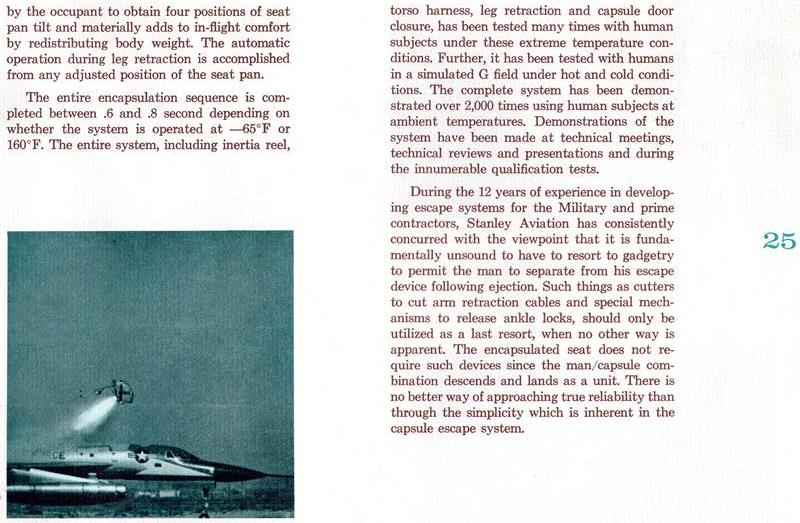 |
| 1962 Supersonic Aircraft Escape Module. |
by the occupant to obtain four positions of seat pan tilt and materially adds to in-flight comfort by redistributing body weight. The automatic operation during leg retraction is accomplished from any adjusted position of the seat pan.
The entire encapsulation sequence is completed between .6 and .8 second depending on whether the system is operated at -65 degrees F or 160 degrees F. The entire system, including inertia reel, torso harness, leg retraction and capsule door closure, has been tested many times with human subjects under these extreme temperature conditions. Further, it has been tested with humans in a simulated G field under hot and cold conditions. The complete system has been demonstrated over 2,000 times using human subjects at ambient temperatures. Demonstrations of the system have been made at technical meetings, technical reviews and presentations and during the innumerable qualification tests.
During the 12 years of experience in developing escape systems for the Military and prime contractors, Stanley Aviation has consistently concurred with the viewpoint that it is fundamentally unsound to have to resort to gadgetry to permit the man to separate from his escape device following ejection. Such things as cutters to cut arm retraction cables and special mechanisms to release ankle locks, should only be utilized as a last resort, when no other way is apparent. The encapsulated seat does not require such devices since the man/capsule combination descends and lands as a unit. There is no better way of approaching true reliability than through the simplicity which is inherent in the capsule escape system.
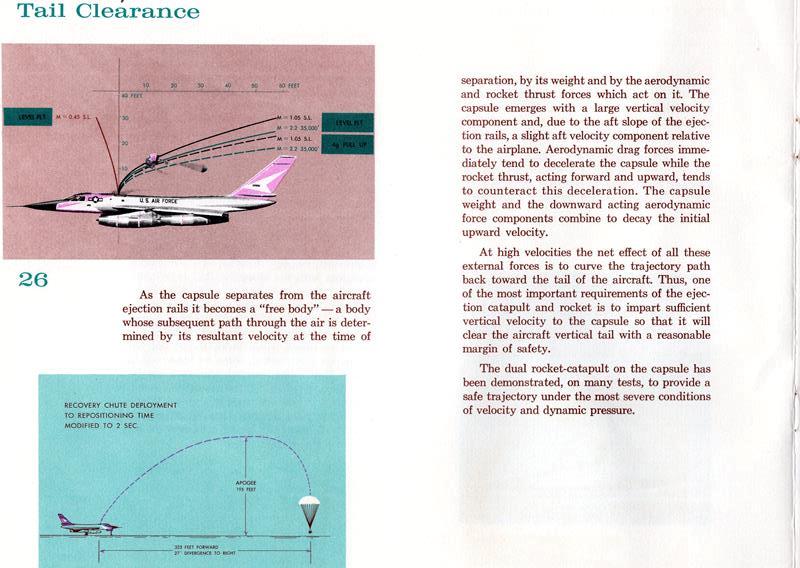 |
| 1962 Supersonic Aircraft Escape Module. |
Tail Clearance
As the capsule separates from the aircraft ejection rails it becomes a "free body" - a body whose subsequent path through the air is determined by its resultant velocity at the time of separation, by its weight and by the aerodynamic and rocket thrust forces which act on it. The capsule emerges with a large vertical velocity component and, due to the aft slope of the ejection rails, a slight aft velocity component relative to the airplane. Aerodynamic drag forces immediately tend to decelerate the capsule while the rocket thrust, acting forward and upward, tends to counteract this deceleration. The capsule weight and the downward acting aerodynamic force components combine to decay the initial upward velocity.
At high velocities the net effect of all these external forces is to curve the trajectory path back toward the tail of the aircraft. Thus, one of the most important requirements of the ejection catapult and rocket is to impart sufficient vertical velocity to the capsule so that it will clear the aircraft vertical tail with a reasonable margin of safety.
The dual rocket-catapult on the capsule has been demonstrated, on many tests, to provide a safe trajectory under the most severe conditions of velocity and dynamic pressure.
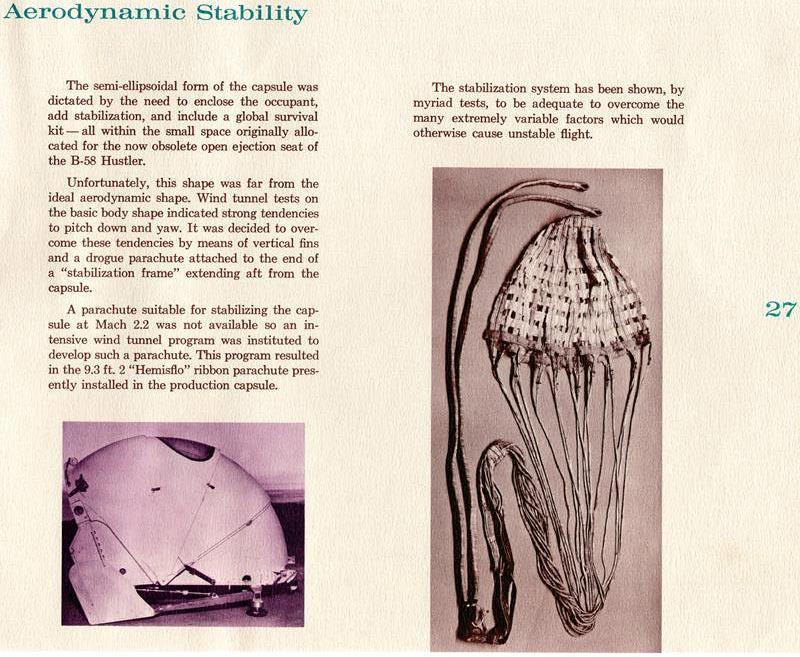 |
| 1962 Supersonic Aircraft Escape Module. |
Aerodynamic Stability
The semi-ellipsoidal form of the capsule was dictated by the need to enclose the occupant, add stabilization, and include a global survival kit - all within the small space originally allocated for the now obsolete open ejection seat of the B-58 Hustler.
Unfortunately, this shape was far from the ideal aerodynamic shape. Wind tunnel tests on the basic body shape indicated strong tendencies to pitch down and yaw. It was decided to overcome these tendencies by means of vertical fins and a drogue parachute attached to the end of a "stabilization frame" extending aft from the capsule.
A parachute suitable for stabilizing the capsule at Mach 2.2 was not available so an intensive wind tunnel program was instituted to develop such a parachute. This program resulted in the 9.3 ft. 2 "Hemisflo" ribbon parachute presently installed in the production capsule.
The stabilization system has been shown, by myriad tests, to be adequate to overcome the many extremely variable factors which would otherwise cause unstable flight.
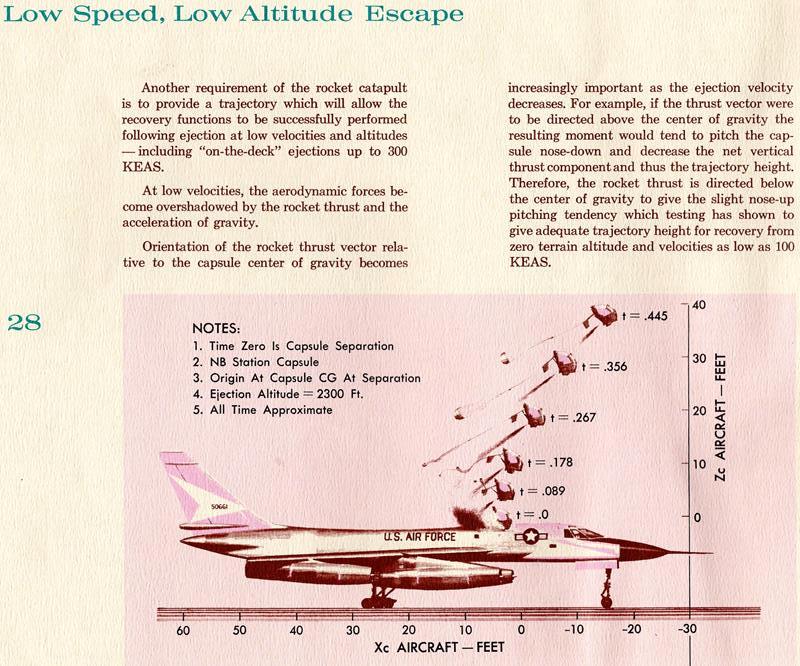 |
| 1962 Supersonic Aircraft Escape Module. |
Low Speed, Low Altitude Escape
Another requirement of the rocket catapult is to provide a trajectory which will allow the recovery functions to be successfully performed following ejection at low velocities and altitudes - including "on-the-deck" ejections up to 300 knots equivalent airspeed (KEAS).
At low velocities, the aerodynamic forces be come overshadowed by the rocket thrust and the acceleration of gravity.
Orientation of the rocket thrust vector relative to the capsule center of gravity becomes increasingly important as the ejection velocity decreases. For example, if the thrust vector were to be directed above the center of gravity the resulting moment would tend to pitch the capsule nose-down and decrease the net vertical thrust component and thus the trajectory height. Therefore, the rocket thrust is directed below the center of gravity to give the slight nose-up pitching tendency which testing has shown to give adequate trajectory height for recovery from zero terrain altitude and velocities as low as 100 KEAS.
DIAGRAM NOTES:
1. Time Zero Is Capsule Separation
2. NB Station Capsule
3. Origin At Capsule CG At Separation
4. Ejection Altitude = 2300 Feet
5. All Times Approximate
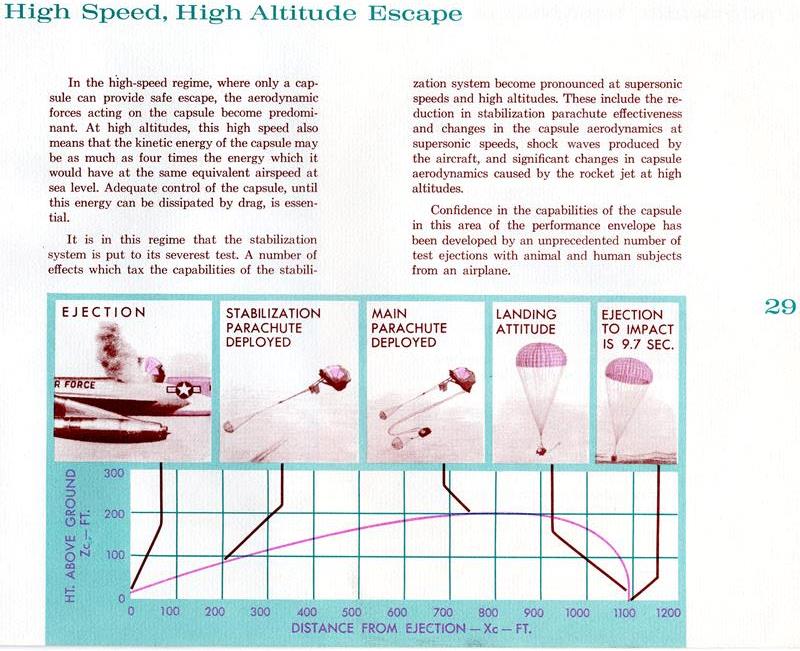 |
| 1962 Supersonic Aircraft Escape Module. |
High Speed, High Altitude Escape
In the high-speed regime, where only a capsule can provide safe escape, the aerodynamic forces acting on the capsule become predominant. At high altitudes, this high speed also means that the kinetic energy of the capsule may be as much as four times the energy which it would have at the same equivalent airspeed at sea level. Adequate control of the capsule, until this energy can be dissipated by drag, is essential.
It is in this regime that the stabilization system is put to its severest test. A number of effects which tax the capabilities of the stabilization system become pronounced at supersonic speeds and high altitudes. These include the reduction in stabilization parachute effectiveness and changes in the capsule aerodynamics at supersonic speeds, shock waves produced by the aircraft, and significant changes in capsule aerodynamics caused by the rocket jet at high altitudes.
Confidence in the capabilities of the capsule in this area of the performance envelope has been developed by an unprecedented number of test ejections with animal and human subjects from an airplane.
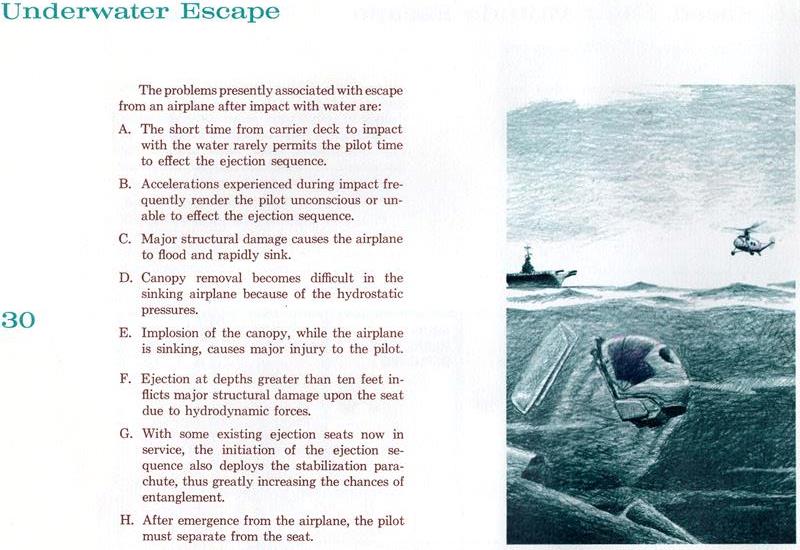 |
| 1962 Supersonic Aircraft Escape Module. |
Underwater Escape
The problems presently associated with escape from an airplane after impact with water are:
A. The short time from carrier deck to impact with the water rarely permits the pilot time to effect the ejection sequence.
B. Accelerations experienced during impact frequently render the pilot unconscious or unable to effect the ejection sequence.
C. Major structural damage causes the airplane to flood and rapidly sink.
D. Canopy removal becomes difficult in the sinking airplane because of the hydrostatic pressures.
E. Implosion of the canopy, while the airplane is sinking, causes major injury to the pilot.
F. Ejection at depths greater than ten feet inflicts major structural damage upon the seat due to hydrodynamic forces.
G. With some existing ejection seats now in service, the initiation of the ejection sequence also deploys the stabilization parachute, thus greatly increasing the chances of entanglement.
H. After emergence from the airplane, the pilot must separate from the seat.
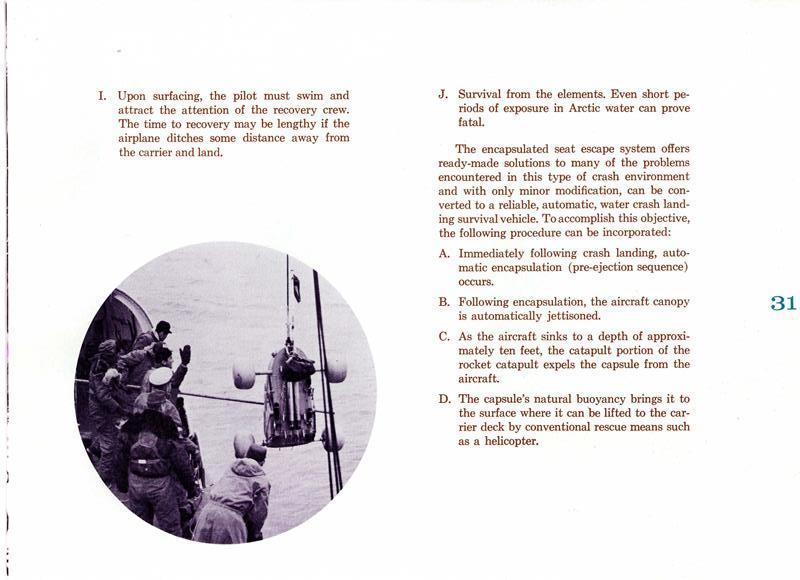 |
| 1962 Supersonic Aircraft Escape Module. |
I. Upon surfacing, the pilot must swim and attract the attention of the recovery crew. The time to recovery may be lengthy if the airplane ditches some distance away from the carrier and land.
J. Survival from the elements. Even short periods of exposure in Arctic water can prove fatal.
The encapsulated seat escape system offers ready-made solutions to many of the problems encountered in this type of crash environment and with only minor modification, can be converted to a reliable, automatic, water crash landing survival vehicle. To accomplish this objective, the following procedure can be incorporated:
A. Immediately following crash landing, automatic encapsulation (pre-ejection sequence) occurs.
B. Following encapsulation, the aircraft canopy is automatically jettisoned.
C. As the aircraft sinks to a depth of approximately ten feet, the catapult portion of the rocket catapult expels the capsule from the aircraft.
D. The capsule's natural buoyancy brings it to the surface where it can be lifted to the carrier deck by conventional rescue means such as a helicopter.
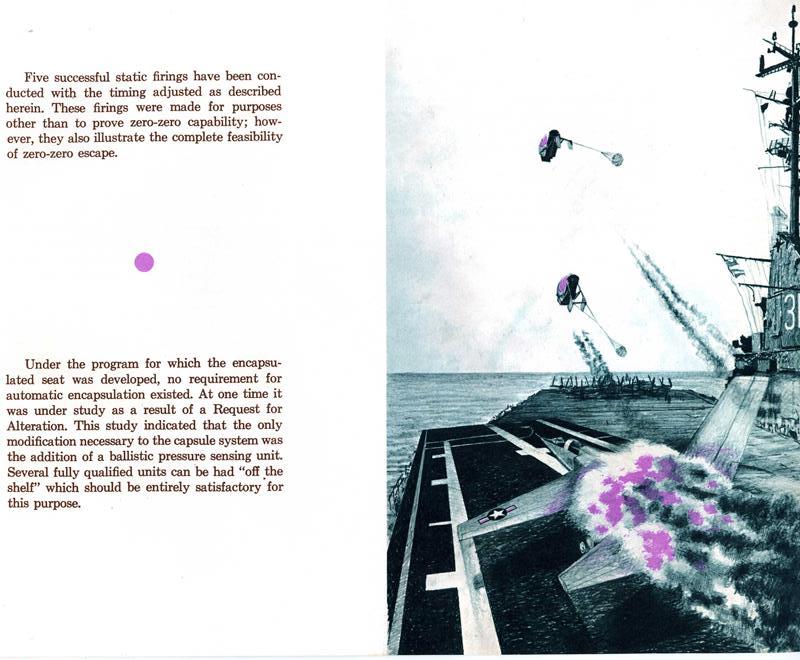 |
| 1962 Supersonic Aircraft Escape Module. |
Zero - Zero Capability
To achieve a zero-zero capability, two minor changes are necessary to the encapsulated seat recovery system. The barometric initiator, which now has a fixed two-second time delay, would become a two-stage timer. An alternate delay of one second would be incorporated for use in the case of ejection below approximately 90 knots equivalent airspeed (KEAS). Automatic selection can be accomplished by an electrical signal from any appropriate aircraft function, such as the landing gear lever. The second modification would be to by-pass the two-second delay in the recovery parachute reefing line cutters. Here again, it would be done electrically during the interval of .3 second between the time the ejection trigger fires the catapult and actual first movement up the rails. The electrical signal would fire the three reefing line cutters (only one required for successful operation) while the capsule is still in the aircraft. To keep this system completely independent of the aircraft electrical system in case of an aircraft power failure, the capsule thermal batteries would be used for the power source.
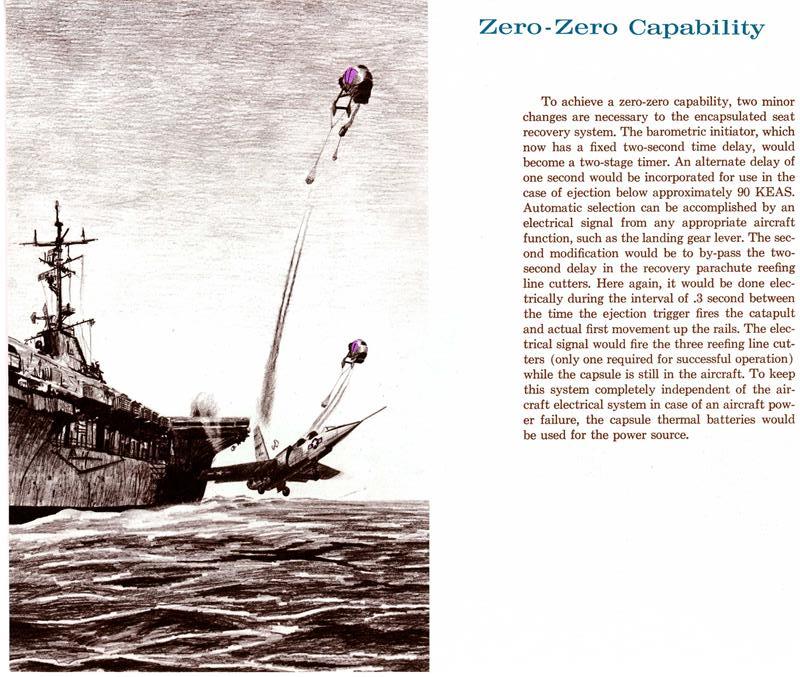 |
| 1962 Supersonic Aircraft Escape Module. |
Five successful static firings have been conducted with the timing adjusted as described herein. These firings were made for purposes other than to prove zero-zero capability; however, they also illustrate the complete feasibility of zero-zero escape.
Under the program for which the encapsulated seat was developed, no requirement for automatic encapsulation existed. At one time it was under study as a result of a Request for Alteration. This study indicated that the only modification necessary to the capsule system was the addition of a ballistic pressure sensing unit. Several fully qualified units can be had "off the shelf" which should be entirely satisfactory for this purpose.
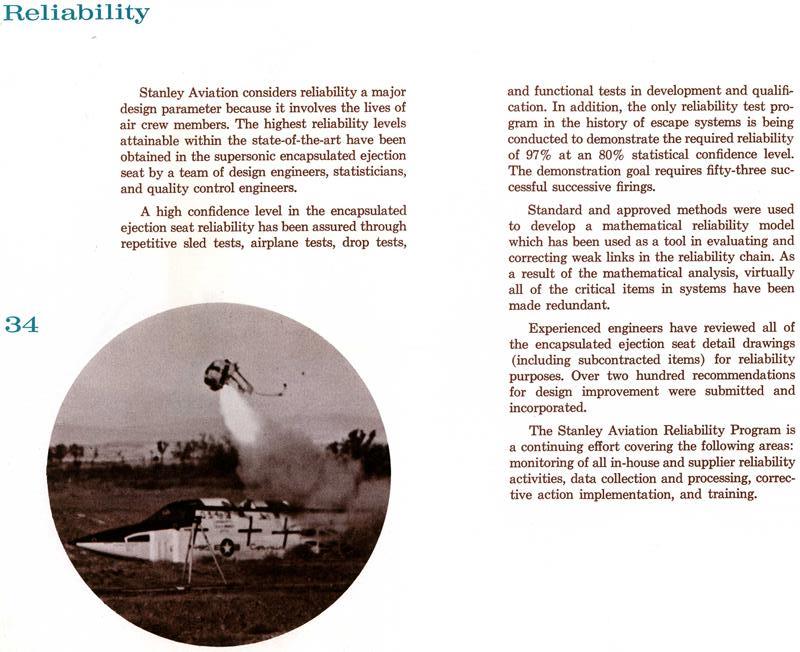 |
| 1962 Supersonic Aircraft Escape Module. |
Reliability
Stanley Aviation considers reliability a major design parameter because it involves the lives of air crew members. The highest reliability levels attainable within the state-of-the-art have been obtained in the supersonic encapsulated ejection seat by a team of design engineers, statisticians, and quality control engineers.
A high confidence level in the encapsulated ejection seat reliability has been assured through repetitive sled tests, airplane tests, drop tests, and functional tests in development and qualification. In addition, the only reliability test program in the history of escape systems is being conducted to demonstrate the required reliability of 97% at an 80% statistical confidence level. The demonstration goal requires fifty-three successful successive firings.
Standard and approved methods were used to develop a mathematical reliability model which has been used as a tool in evaluating and correcting weak links in the reliability chain. As a result of the mathematical analysis, virtually all of the critical items in systems have been made redundant.
Experienced engineers have reviewed all of the encapsulated ejection seat detail drawings (including subcontracted items) for reliability purposes. Over two hundred recommendations for design improvement were submitted and incorporated.
The Stanley Aviation Reliability Program is a continuing effort covering the following areas: monitoring of all in-house and supplier reliability activities, data collection and processing, corrective action implementation, and training.
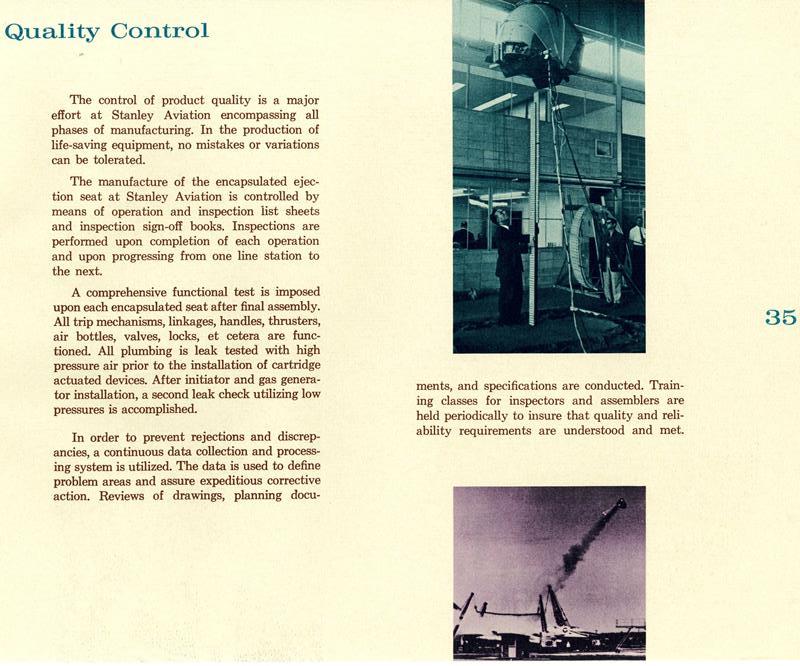 |
| 1962 Supersonic Aircraft Escape Module. |
Quality Control
The control of product quality is a major effort at Stanley Aviation encompassing all phases of manufacturing. In the production of life-saving equipment, no mistakes or variations can be tolerated.
The manufacture of the encapsulated ejection seat at Stanley Aviation is controlled by means of operation and inspection list sheets and inspection sign-off books. Inspections are performed upon completion of each operation and upon progressing from one line station to the next.
A comprehensive functional test is imposed upon each encapsulated seat after final assembly. All trip mechanisms, linkages, handles, thrusters, air bottles, valves, locks, et cetera are functioned. All plumbing is leak tested with high pressure air prior to the installation of cartridge actuated devices. After initiator and gas generator installation, a second leak check utilizing low pressures is accomplished.
In order to prevent rejections and discrepancies, a continuous data collection and processing system is utilized. The data is used to define problem areas and assure expeditious corrective action. Reviews of drawings, planning documents, and specifications are conducted. Training classes for inspectors and assemblers are held periodically to insure that quality and reliability requirements are understood and met.
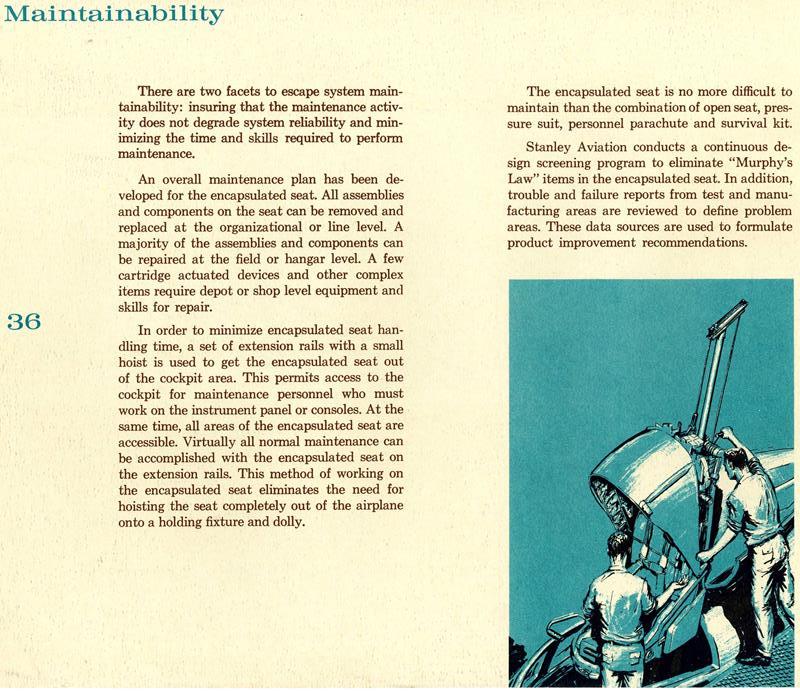 |
| 1962 Supersonic Aircraft Escape Module. |
Maintainability
There are two facets to escape system maintainability: insuring that the maintenance activity does not degrade system reliability and minimizing the time and skills required to perform maintenance.
An overall maintenance plan has been developed for the encapsulated seat. All assemblies and components on the seat can be removed and replaced at the organizational or line level. A majority of the assemblies and components can be repaired at the field or hangar level. A few cartridge actuated devices and other complex items require depot or shop level equipment and skills for repair.
In order to minimize encapsulated seat handling time, a set of extension rails with a small hoist is used to get the encapsulated seat out of the cockpit area. This permits access to the cockpit for maintenance personnel who must work on the instrument panel or consoles. At the same time, all areas of the encapsulated seat are accessible. Virtually all normal maintenance can be accomplished with the encapsulated seat on the extension rails. This method of working on the encapsulated seat eliminates the need for hoisting the seat completely out of the airplane onto a holding fixture and dolly.
The encapsulated seat is no more difficult to maintain than the combination of open seat, pressure suit, personnel parachute and survival kit.
Stanley Aviation conducts a continuous design screening program to eliminate "Murphy's Law" items in the encapsulated seat. In addition, trouble and failure reports from test and manufacturing areas are reviewed to define problem areas. These data sources are used to formulate product improvement recommendations.
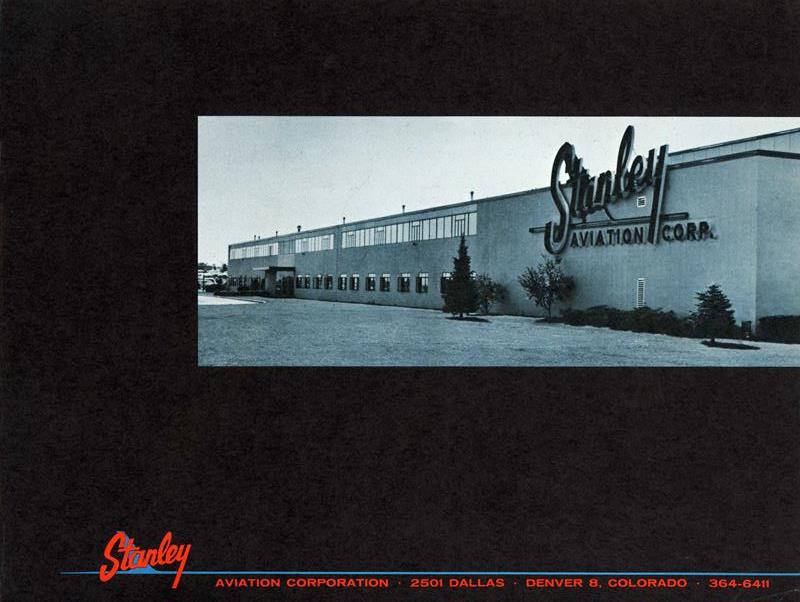 |
| 1962 Supersonic Aircraft Escape Module. |
 |
| 1962 Supersonic Aircraft Escape Module. |
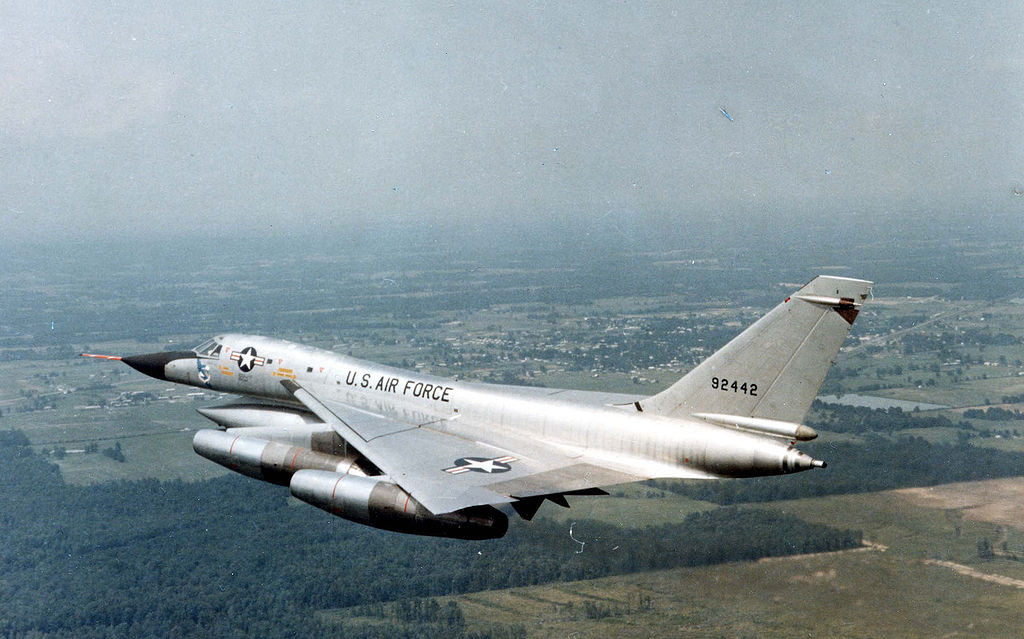 |
| B-58 Hustler. |
"Convair B-58A Hustler in flight (SN 59-2442). Photo taken on June 29, 1967 061101-F-1234P-019" by US Goverment. Licensed under Public Domain via Commons - https://commons.wikimedia.org/wiki/File:
Convair_B-58A_Hustler_in_flight_(SN_59-2442)._
Photo_taken_on_June_29,_1967_061101-F-1234P-019.jpg#/media/File:
Convair_B-58A_Hustler_in_flight_(SN_59-2442)._
Photo_taken_on_June_29,_1967_061101-F-1234P-019.jpg
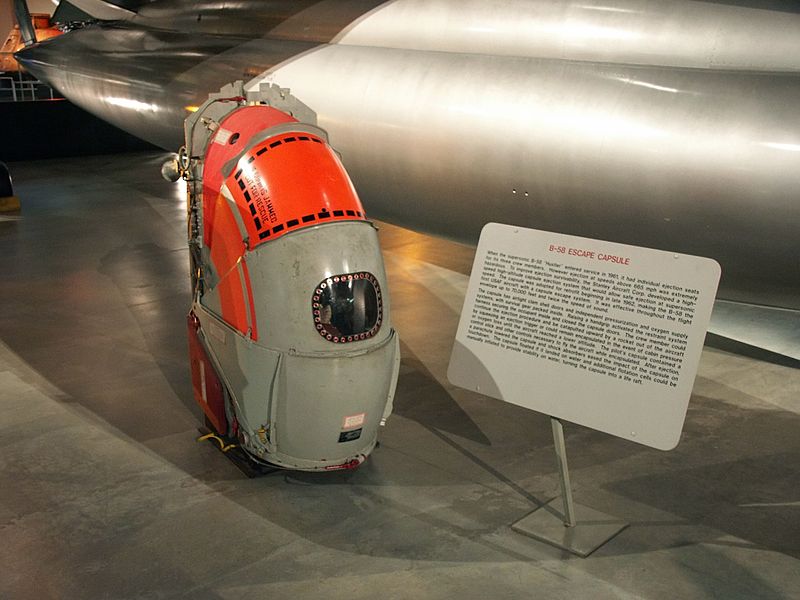 |
| B-58 Hustler Escape Capsule. |
"B-58 Escape Capsule" by Photograph by User:J Clear at en.wikipedia; sign text by National Museum of the United States Air Force staff. - Own work. Licensed under Public Domain via Commons - https://commons.wikimedia.org/wiki/File:
B-58_Escape_Capsule.jpg#/media/File:
B-58_Escape_Capsule.jpg
B-58 ESCAPE CAPSULE
When the supersonic B-58 Hustler entered service in 1961, it had individual ejection seats for the three crew members. Projected ejection at speeds above 665 mph was extremely hazardous. To improve ejection survivability, the Stanley Aircraft Corp. developed a high-speed , high-altitude capsule ejection system that would allow safe ejection at supersonic speeds. The capsule was scheduled for retrofit beginning in late 1962, making the B-58 the first USAF aircraft with a capsule escape system. It was effective throughout the flight envelope up to 70,000 feet and twice the speed of sound.
The capsule has airtight clam shell doors and independent pressurization and oxygen supply systems with survival gear packed inside. Raising a handgrip activated the restraint system harness securing the occupant inside and closed the capsule doors. The crew member could initiate the ejection procedure and be catapulted upward by a rocket out of the aircraft by squeezing an ejection trigger or could remain encapsulated in the event of cabin pressure or oxygen loss until the aircraft could reach a lower altitude. The pilotís capsule contained a control stick and other controls necessary to fly the aircraft while encapsulated. After ejection, a parachute lowered the capsule and shock absorbers eased the impact of the capsule on touchdown. The capsule floated if it landed on water and additional floatation cells could be manually inflated to provide stability on water, turning the capsule into a life raft.
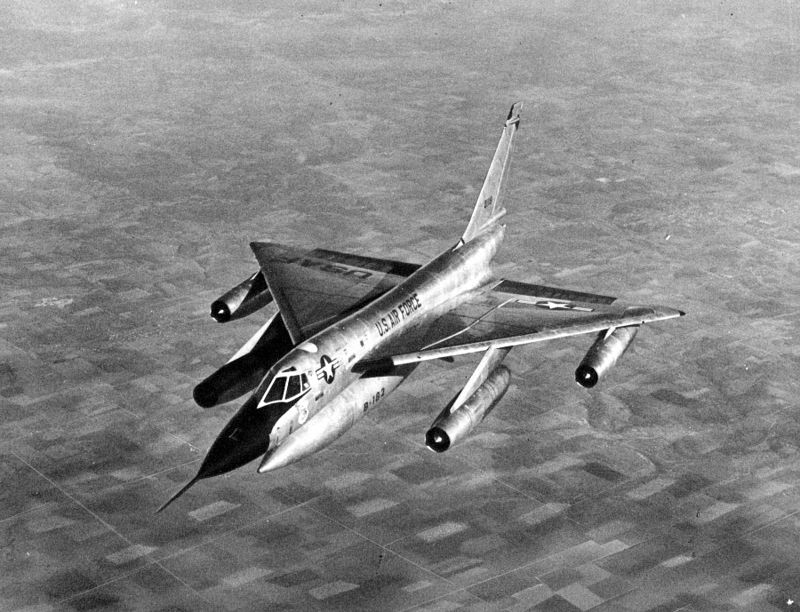 |
| B-58 Hustler. |
"B-58 Hustler". Licensed under Public Domain via Commons - https://commons.wikimedia.org/wiki/File:
B-58_Hustler.jpg#/media/File:
B-58_Hustler.jpg
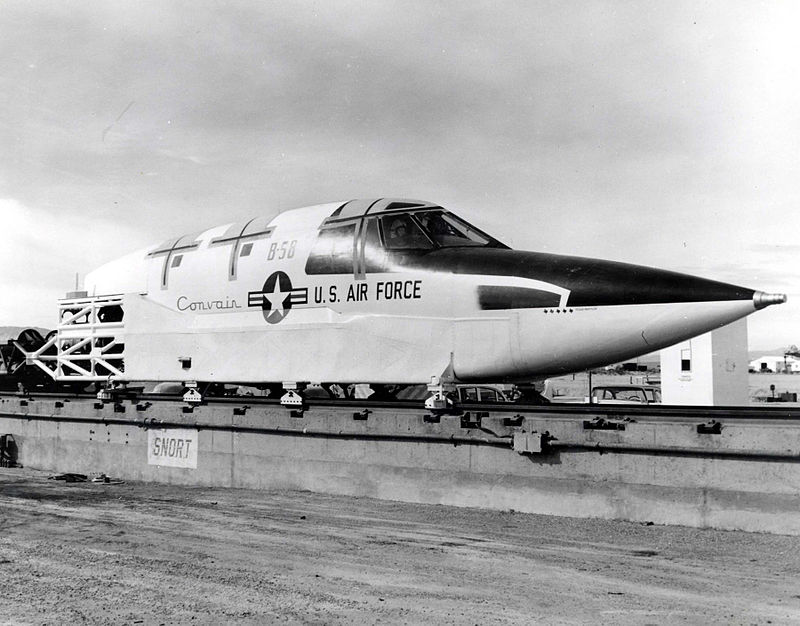 |
| B-58 Hustler Ejection Capsule. |
"Convair B-58 Ejection Capsule 3-4 front view 061101-F-1234P-012" by US Goverment. Licensed under Public Domain via Commons - https://commons.wikimedia.org/wiki/File:
Convair_B-58_Ejection_Capsule_3-4_front_
view_061101-F-1234P-012.jpg#/media/File:
Convair_B-58_Ejection_Capsule_3-4_front_
view_061101-F-1234P-012.jpg
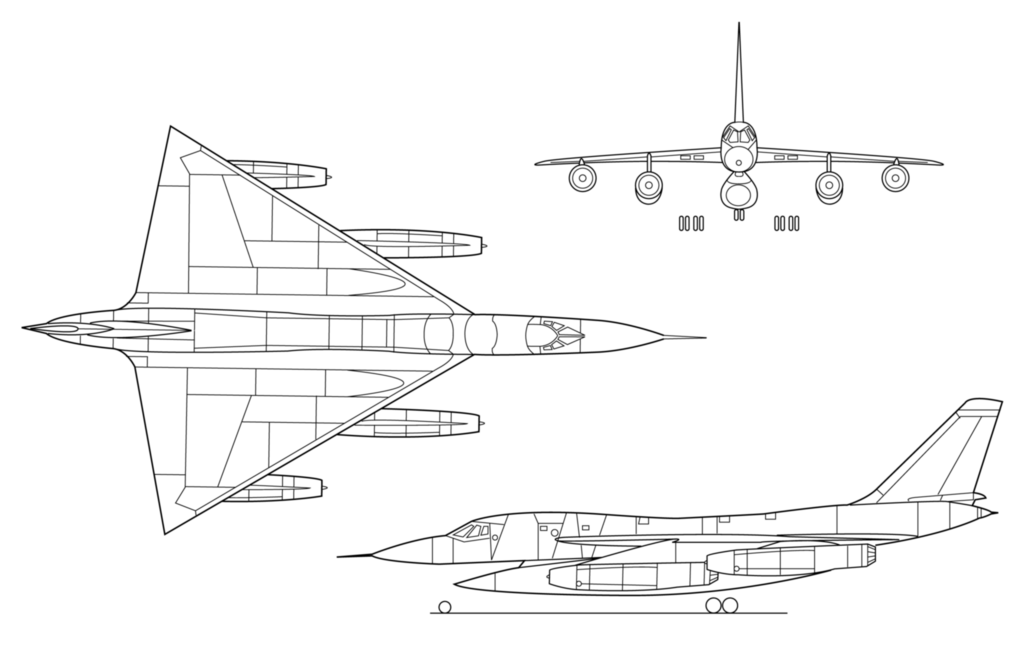 |
| B-58 Hustler Engineering Plan. |
"B-58 3view" by NASA EG-0008-01 - This image or video was catalogued by one of the centers of the United States National Aeronautics and Space Administration (NASA) under Photo ID: EG-0008-01.This tag does not indicate the copyright status of the attached work. A normal copyright tag is still required. See Commons:Licensing for more information. Licensed under Public Domain via Commons - https://commons.wikimedia.org/wiki/
File:B-58_3view.png#/media/
File:B-58_3view.png
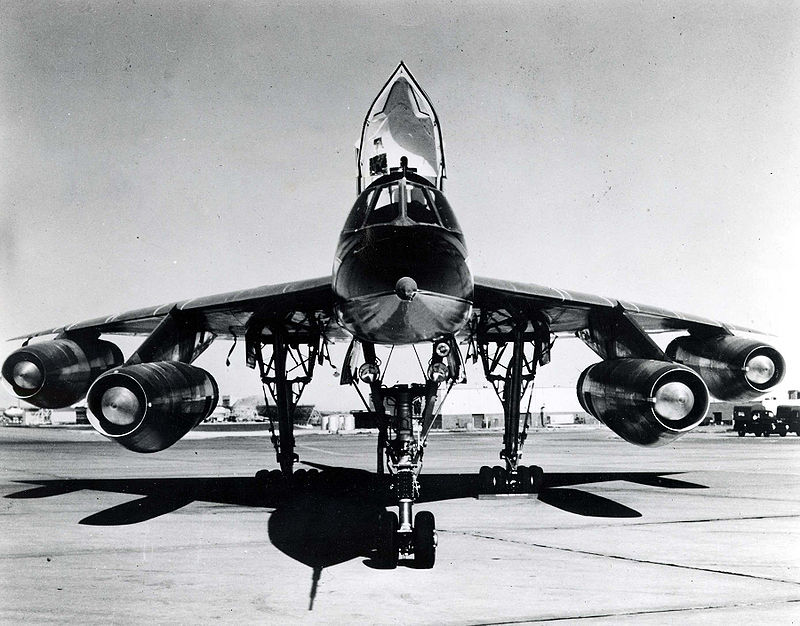 |
| B-58 Hustler. |
"Convair B-58A Hustler front view 061101-F-1234P-021" by US Goverment. Licensed under Public Domain via Commons - https://commons.wikimedia.org/wiki/File:
Convair_B-58A_Hustler_front_
view_061101-F-1234P-021.jpg#/media/File:
Convair_B-58A_Hustler_front_
view_061101-F-1234P-021.jpg
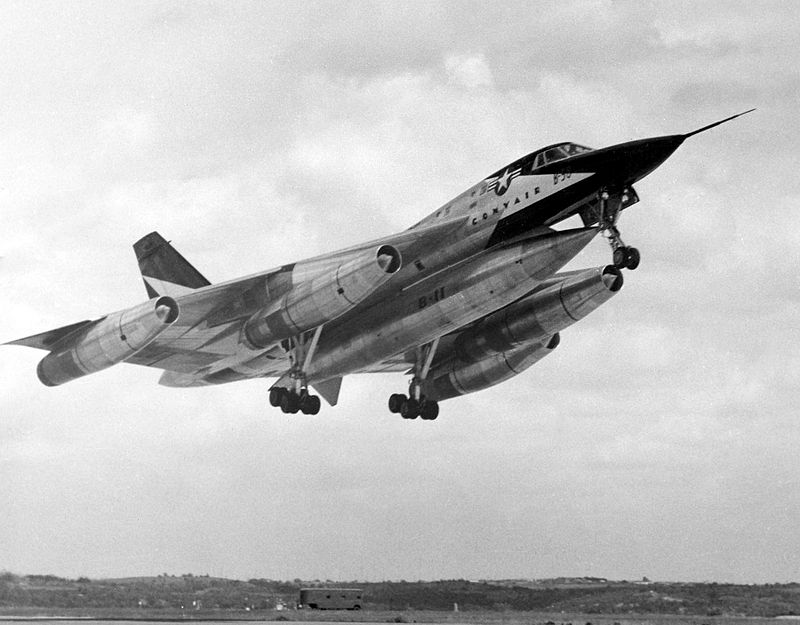 |
| B-58 Hustler Taking Off. |
"Convair XB-58 Hustler during takeoff 061101-F-1234P-008". Licensed under Public Domain via Commons - https://commons.wikimedia.org/wiki/File:Convair_XB-58_Hustler_during_takeoff_061101-F-1234P-008.jpg#/media/File:Convair_XB-58_Hustler_during_takeoff_061101-F-1234P-008.jpg
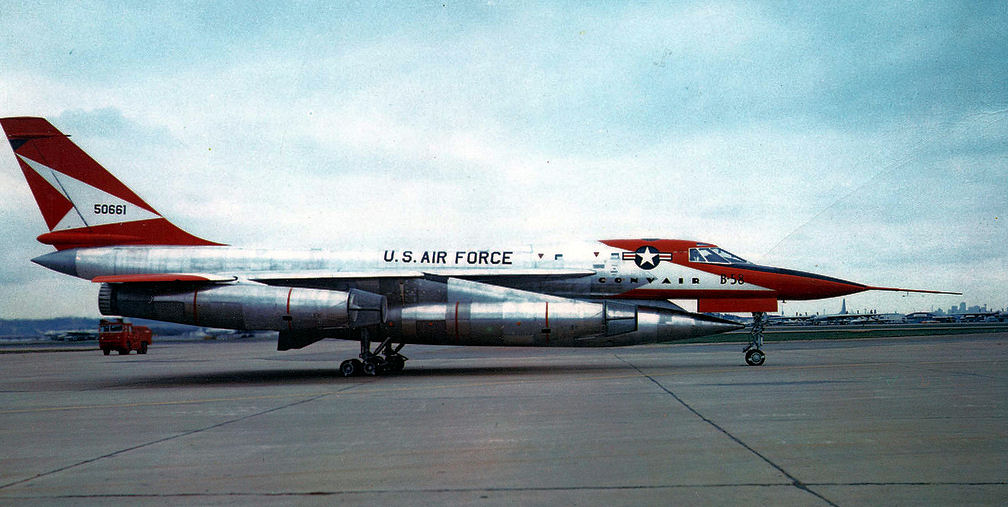 |
| B-58 Hustler. |
"Convair YB-58A-1-CF Hustler 55-661" by United States Air Force - United States Air Force via http://www.flickr.com/photos/18532986@N07/5012789115/in/photostream. Licensed under Public Domain via Commons - https://commons.wikimedia.org/wiki/File:
Convair_YB-58A-1-CF_
Hustler_55-661.jpg#/media/File:
Convair_YB-58A-1-CF_
Hustler_55-661.jpg